Podcasting for Business
For when podcasting is just part of the job.
The State of Business Podcasting Report 2023
Since 2020, One Stone Creative has published an annual research report that does a deep-dive into what the top 100 business podcasts do with their podcasts from show structure, to branding to social media.
MORE DATA MEANS MORE UNDERSTANDING
On this page, you’ll find the results of this year’s report, and our analysis of how to use the information in your own podcast, or for your clients.
For more information, to book podcast interviews, or request a blog post about these results for your audience, you can reach out to Megan Dougherty at Megan (at) onestonecreative (dot) net.
Cadence and Reach
Top 100 Churn: 42%
Churn has increased over last year, from 30% to 42 percent of new shows on the Top 100 list.
Something we noticed while looking at the top lists is that it can change extremely quickly. We reviewed the list again just a week after initially collecting the data, and there had already been significant change. Since 15% of the shows on the list were under a year old, we can assume they were launched with a strong top 100 strategy in mind – that means an aggressive launch campaign trying to get as many downloads as possible in the first days and weeks of release. This strategy can be effective but isn’t necessary for many company shows.
This means that if you’re thinking about launching a new show, if being able to say “Top 100 in our category” is important, you might want to consider working with a consultant or producer who specializes in that particular strategy.
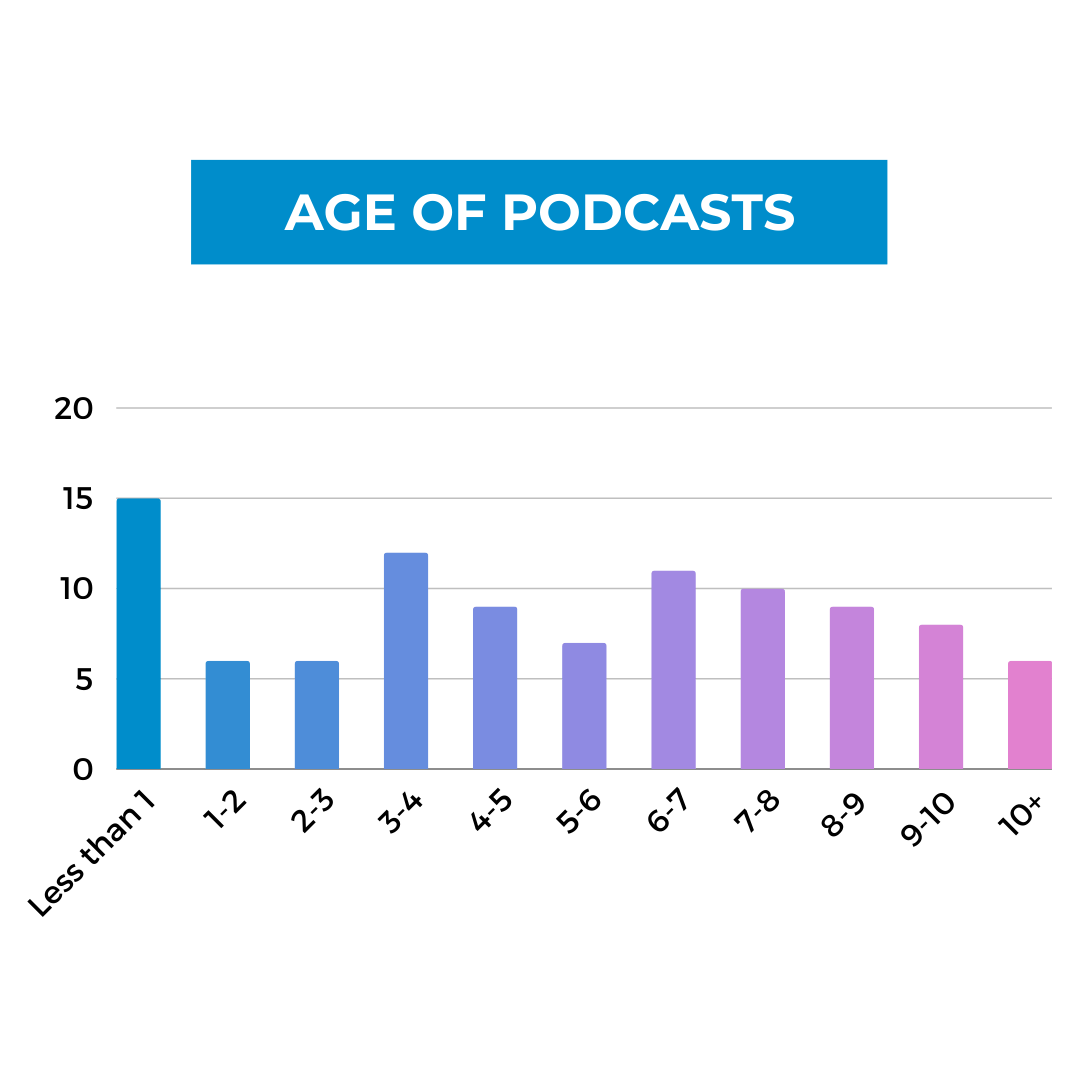
What we can see from the data is that podcasting is a long game. The vast majority of the top 100 podcasts have been in production for three years or more. When you’re thinking about your show, always remember how the value and benefit of creating it compound over time – not only are you serving your audience on an ongoing basis, but you’re establishing a massive professional network and creating a huge archive of content that can be used within your business.
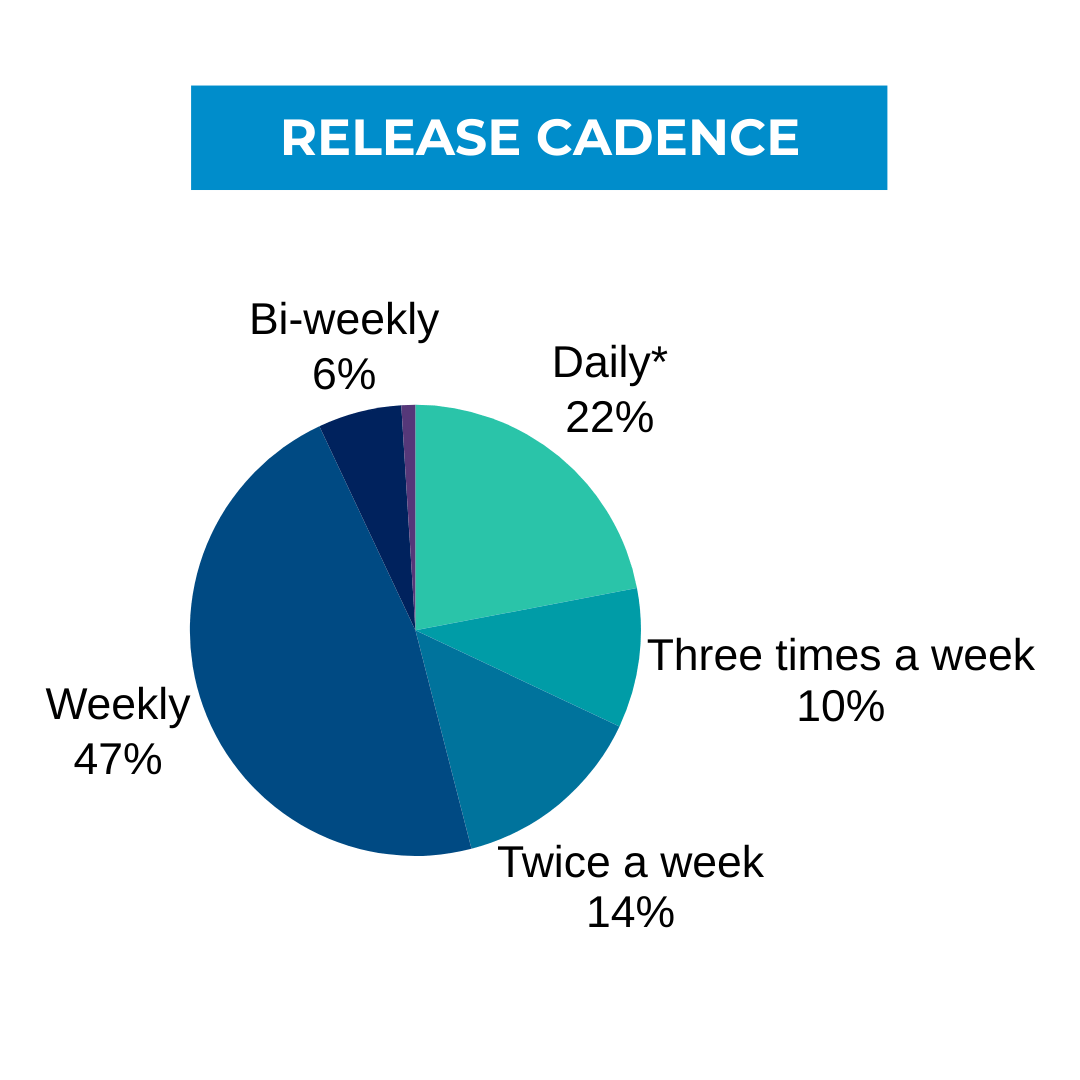
Weekly is the most popular release cadence, with nearly half of all shows releasing on this schedule. And of the rest, only 6 percent release less than that. Daily releases make up nearly a quarter and 2 or 3 a week make up the final quarter.
That one little sliver is multiple daily releases – not for the faint of heart!
A weekly cadence is enough to keep the interest of an audience, and slow enough that you have time to work on promotion, repurposing and relationship building while still making regular progress towards your goals.
All things being equal – try to release weekly and use enough systems and automation to save bandwidth for guesting, repurposing and promoting!
A lot of those daily, or multiple-per-week releases tended to be shorter, or repurposed content from a longer weekly episode – and low on editing, which may or may not be the type of impression you want to make on your audience, or created by a team whose full-time job is that podcast and nothing else.
If increasing your weekly listeners is important to your goals, then you might want to try adding to your release schedule, and producing more content each week. Recording a solo, or a segment of each interview that can be released as a solo can be a way to batch the work and get more content.
Another strategy would be to use clips of old shows, repurposed as is, or with new commentary to add an extra release to your weekly schedule.
As always, the most important thing is creating a schedule and sticking to it!
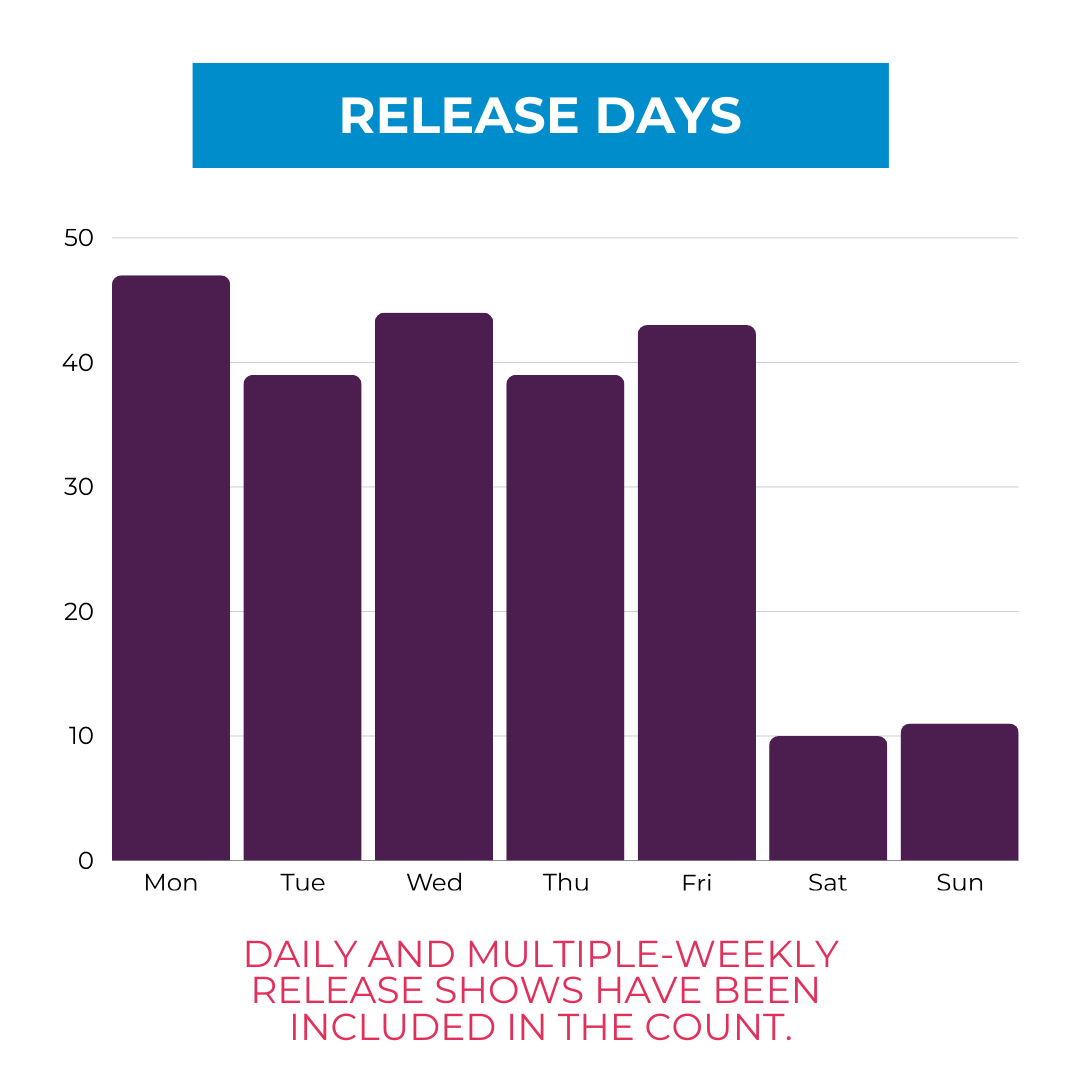
There was a pretty even spread of releases throughout the working week, without enough difference between them to indicate a clear “best” day.
Ultimately, what matters more than the day of the week is that you are consistent, and the workflow around your podcast fits into the other work you and your team have going on!

7% of the top 100 podcasts are seasonal shows, either one-offs or released in regular seasons throughout the year – this can be a great strategy if you’re experimenting with podcasting for the first time, or don’t want to commit to an ongoing schedule.
A well-produced season once or twice a year can help you meet your content and networking goals. Shows that are designed for Audience Engagement or Conversion are likely going to need a more regular release schedule.
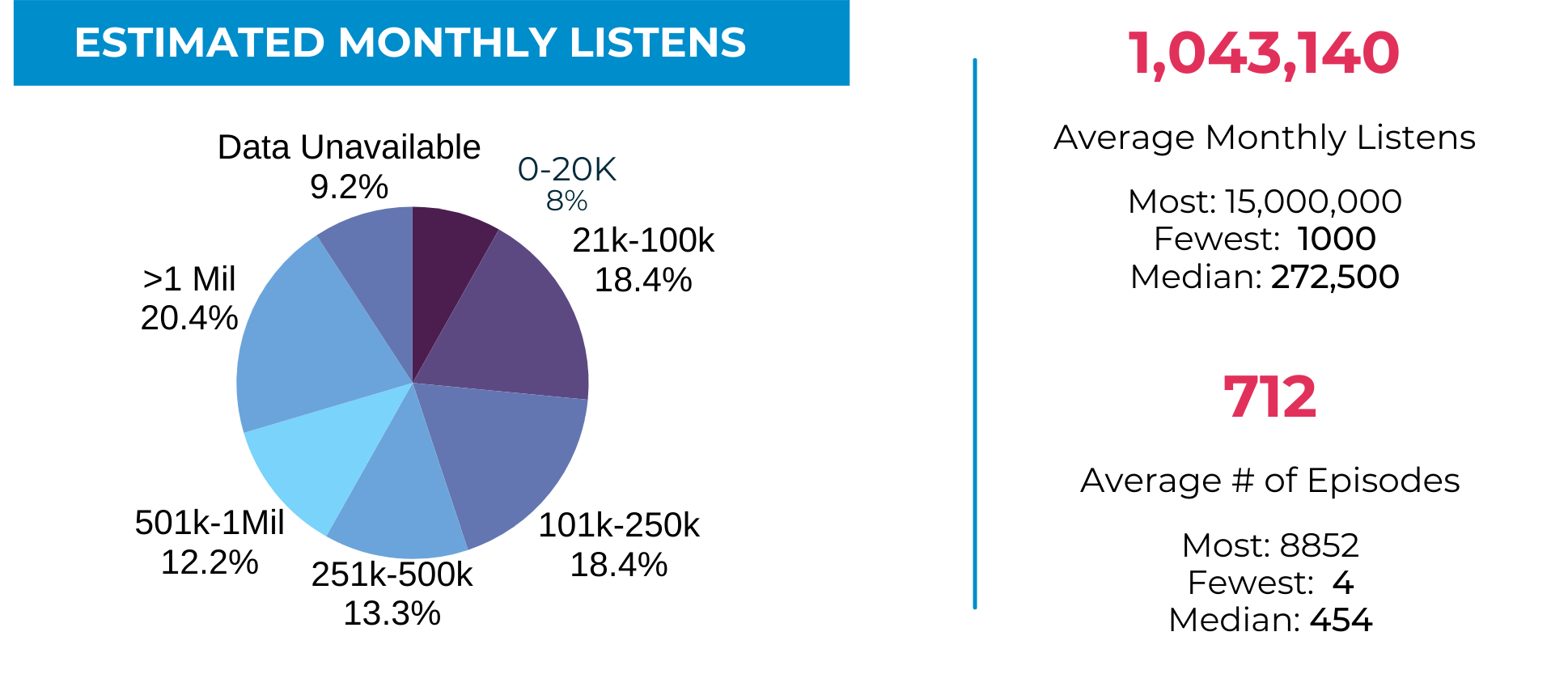
The monthly listens and number of episodes are really just for interest – you don’t need anything near millions of listens to get good value out of your podcast, and the number of episodes you have is the number of episodes you have.
I think the most interesting thing here is that the top 100 shows that had the fewest listens and episodes actually have a very achievable number of results. This means that you can play with the big boys without necessarily being one of them.
There was one show with over 8k episodes that is actually an RSS Roundup feed of multiple shows created by a content network. There were two such shows represented, and if you host multiple podcasts, then creating an all-in-one feed can be a great way to get more listens and downloads, as well as make like easy for your biggest fans.
To the best of my current knowledge – and do let me know if you have more recent info – this does not include YouTube data, despite the new podcasts feature.
Branding
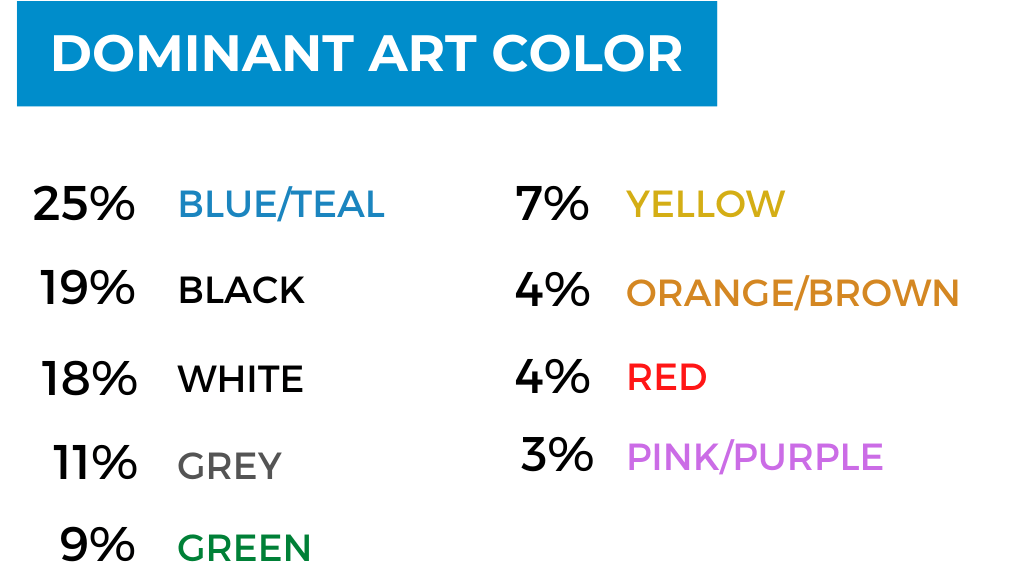
Blue is the top Podcast Cover Art colour for the 4th year in a row – but just like last year, and the year before that the most important thing is that it matches your overall branding and the feeling you want to convey with the show. Keep your fonts, image treatments and colors aligned and your whole body of work will look consistent.

People like people, and having a headshot in your cover art remains a popular choice. This is a slight decrease from last year, and typographic-only logos are less common as well, more of the top 100 are using logo or graphic based cover art.
In analysing the shows, if the cover art had a graphic or artistic rendering of the host or hosts, we called it a headshot art, the graphics or logos refer to non-human graphics.
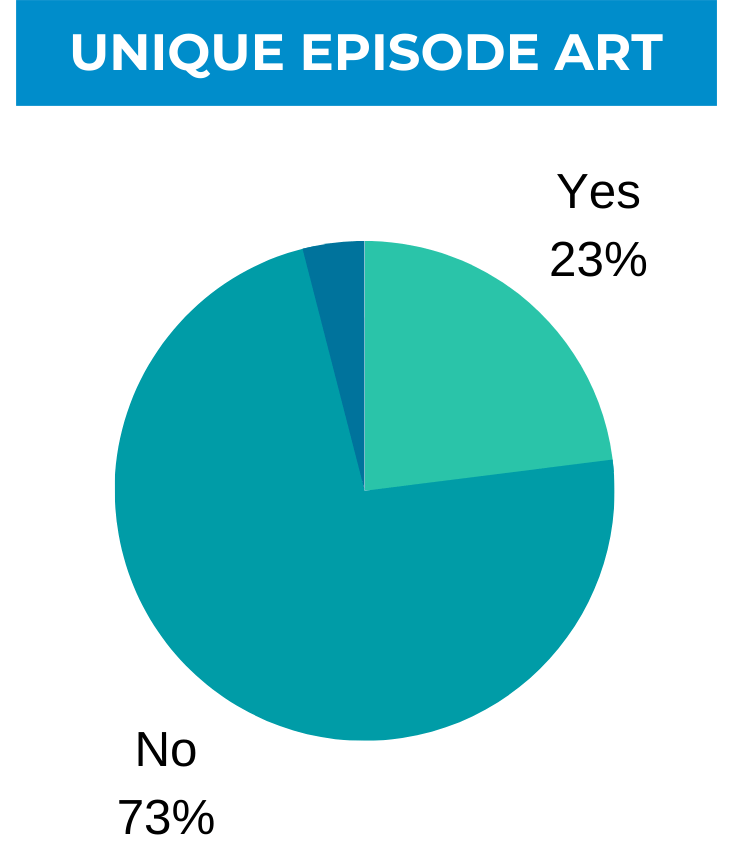
Speaking of art, let’s talk quickly about episode-specific art. Most shows don’t create it, only 23% did on regular shows and another 4 do to denote different episode types (like Interview, Clip, or News!)
That means that if you do decide to make unique art or title cards for each episode, it will differentiate your show somewhat, and it can be a nice little benefit for guests.
This would be totally optional, however.

Finally – names in podcast titles – if your business is built around you, your name and your personality, then you should put your name in the podcast name.
This year 29% of the top 100 shows were “named” podcasts this year – a 6% decrease from last year.
A lot of these shows are hosted by public thinkers whose business is all about people knowing and respecting their names.
If that is a goal for your own business, then get your name in the title if it isn’t there already! If your interest is more in audience engagement or relationship building, however, then there’s no need to make it a “named” show unless you want to.
The key question is – what is the most compelling your name or your topic? That is going to vary a lot by business.
I included shows that had the name as an equal part of the rest of the title, and included in the name on the podcatchers rather than included in small subtitle text and not within the official Spotify podcast name.
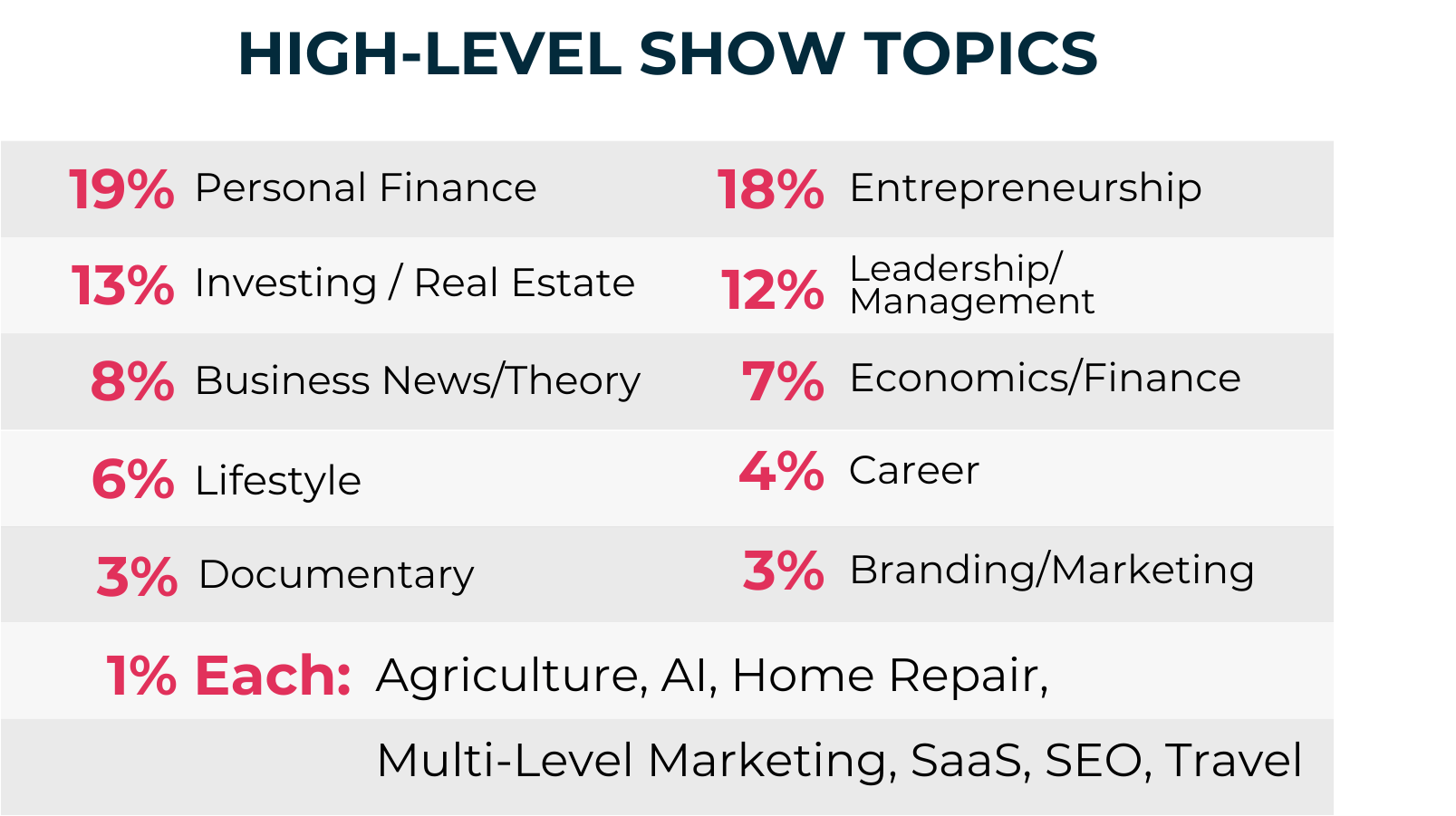
High-level show topics is also mainly for interest as your show’s topic is going to be your business topic!
There was a little more variety in show topics this year compared to last, which I think means different kinds of businesses are making podcasting a large part of their marketing strategy – something I love seeing.
Show Structure
As we get into show structure, I want to give you a little background on one of the mechanisms we use to evaluate (and produce!) company podcasts.
Each podcast needs to have a high-level podcast purpose – a prime directive that helps make all of the strategic decisions you’ll make about the show: over the years we’ve identified 5 of them…
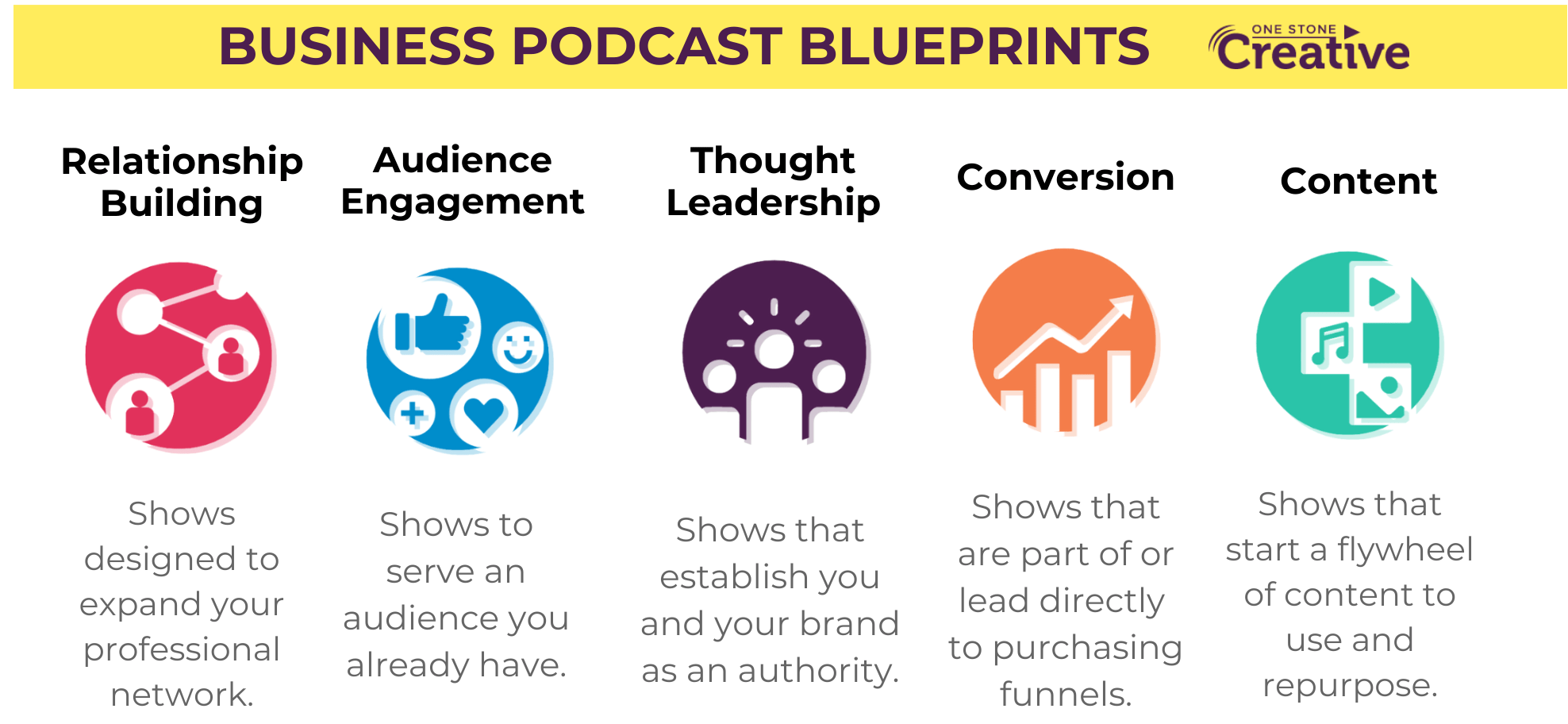
As we looked at the top 100 shows, we tried to the best of our ability, to identify which blueprint they seemed to be using. I want to very clearly preface the following with the fact this this is our outside opinion – The Business Podcast Blueprints are a concept developed and used by us at One Stone Creative – it is not a widely known methodology for planning or analyzing podcasts outside of our company… yet.
It’s also important to remember that this is our opinion from looking at the externally available elements of the show – we could be wrong based on the priorities and plans of the people who created these shows.
Understood? Excellent. Then here’s what we think…
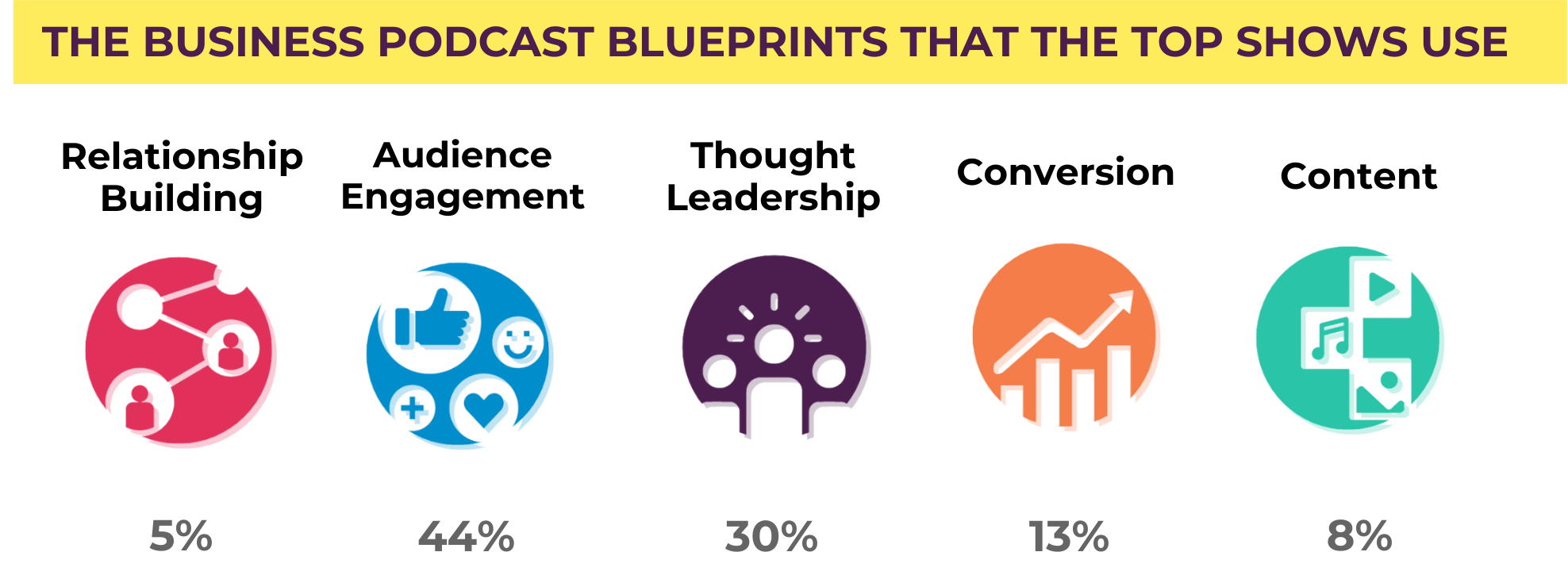
We looked at each show, and what they were doing with sponsorship, website, presentation, promotion, CTAs, Engagement and asked – what blueprint would have encouraged us to make these choices?
Some interesting things here. Generally, sponsorship is not an indication of a thought leadership style podcast, EXCEPT in the case of a “presented by” show. (There is no reason your podcast can’t be presented by your own company)
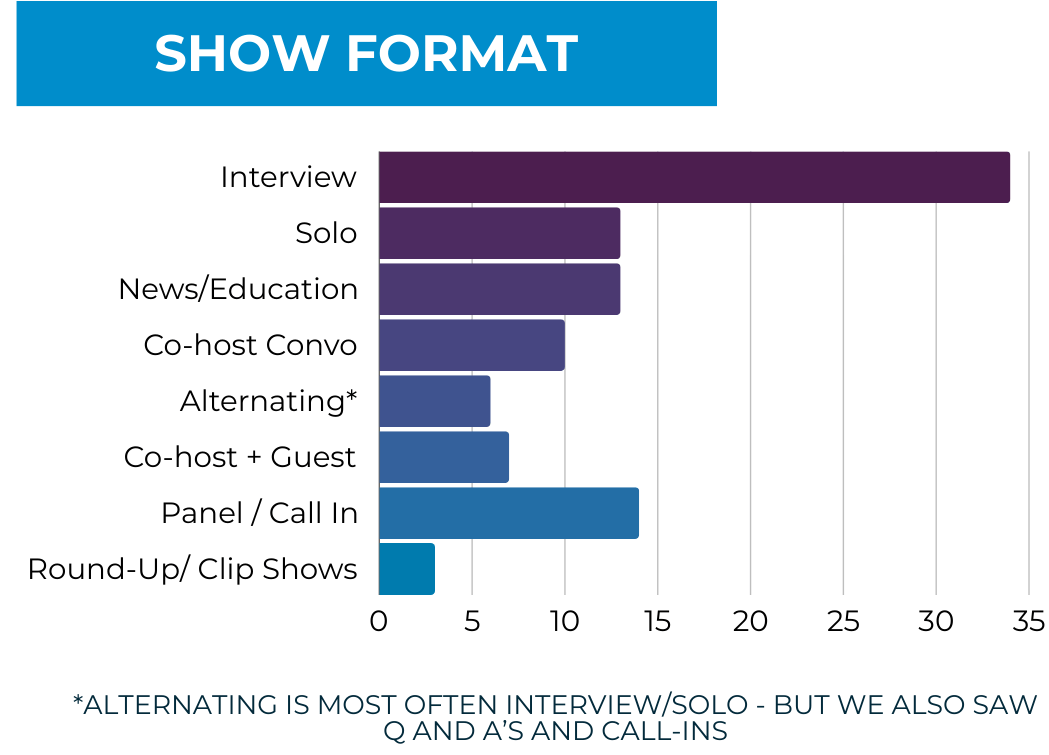
In terms of the show format, most were interview shows (it is the easiest way to integrate guests!), and of the other formats we looked at there was a pretty even spread between news/documentary style, cohost conversations, alternating between two formats, co-host interviews, solo episodes and panel or call-in style shows.
Your own show format depends on your goals, and the types 82% of the top 100 business podcasts had guests as the main body of their episodes or in segments of some kind. This is a slight decrease from last year and is a solid indication that both business owners and listening audiences value the conversations hosts have with guests on their shows.
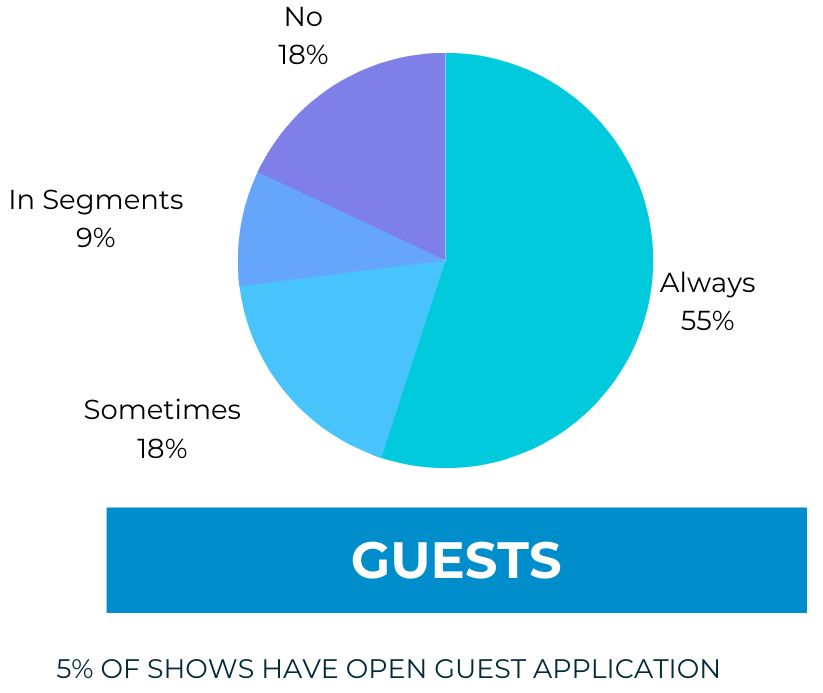
If your main goal for podcasting is relationship building, then you’re absolutely going to have guests.
If you are working towards thought leadership or audience engagement, then guests can be a powerful way to address more ideas and topic areas than you can as a solo creator. And if your show exists only to create content, then more guests = more content!
Very short episodes or segments within longer episodes can do very well on social media, and on the other hand, solos and cohost conversations are powerful ways to create huge amounts of content for big repurposing projects!
Alternating show types can be a popular option, especially when you have an audience you want to engage with. Alternating conversations with experts who can help them and answering their questions yourself in Q and A style episodes is a particularly popular strategy, and one we can recommend highly!

The length of podcast episodes is nearly the same as last year again – this has been an extremely consistent datapoint since we’ve been doing the report – we started with 44 minutes, then 43 and now, 42 minutes for regular releases.
A podcast episode should be as long as it needs to be to explore what you want it too, but when you start to exceed the 35-45 minute range you are going to be at more risk of alienating busier people.
Something I have found is that, especially for newer interviewers, putting a restriction on length leads to much stronger content.
If you know you only have 30 minutes for the call, then you get to the “meat” much faster – and it also helps you get over the idea that you don’t want to press, or interrupt your guest too much – sometimes it is warranted!
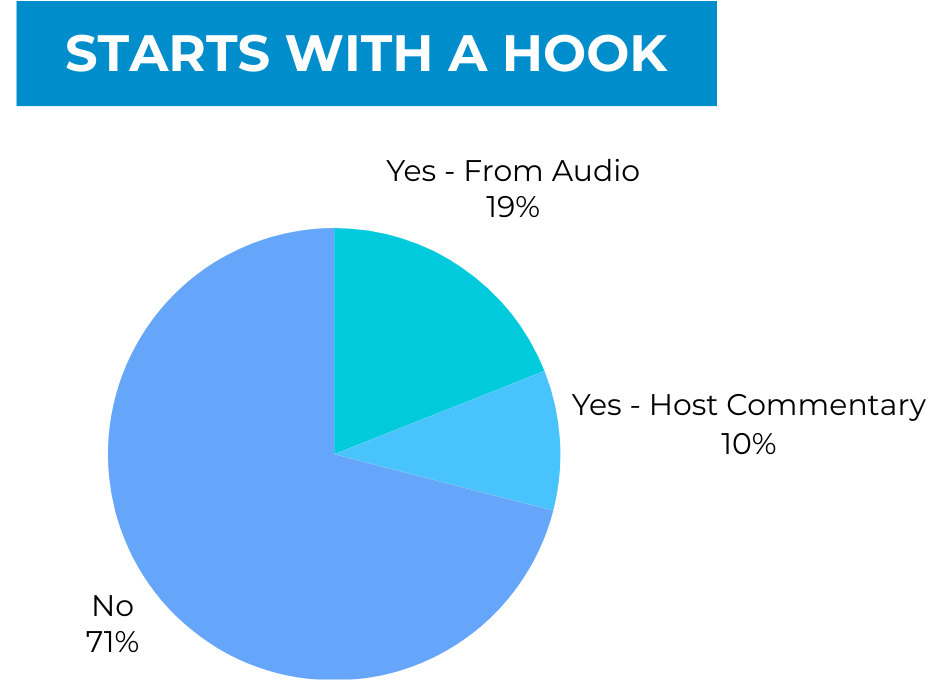
After two years of decreasing, I think we can safely say that hooks are officially out.
A hook, or sizzle clip, is a piece of audio either recorded separately by the host or pulled from the main body of the episode that is played before the main intro. Hooks are a good way to set the tone of a podcast, and pique curiosity, but they seem to have fallen out of favor among the top 100.
If I had to guess why, would say it is the increasing presence of short form video as a promotional and engagement piece – most shows now make multiple “hook” pieces of content and send them out into the world, meaning there is already a tone set when people hit play.
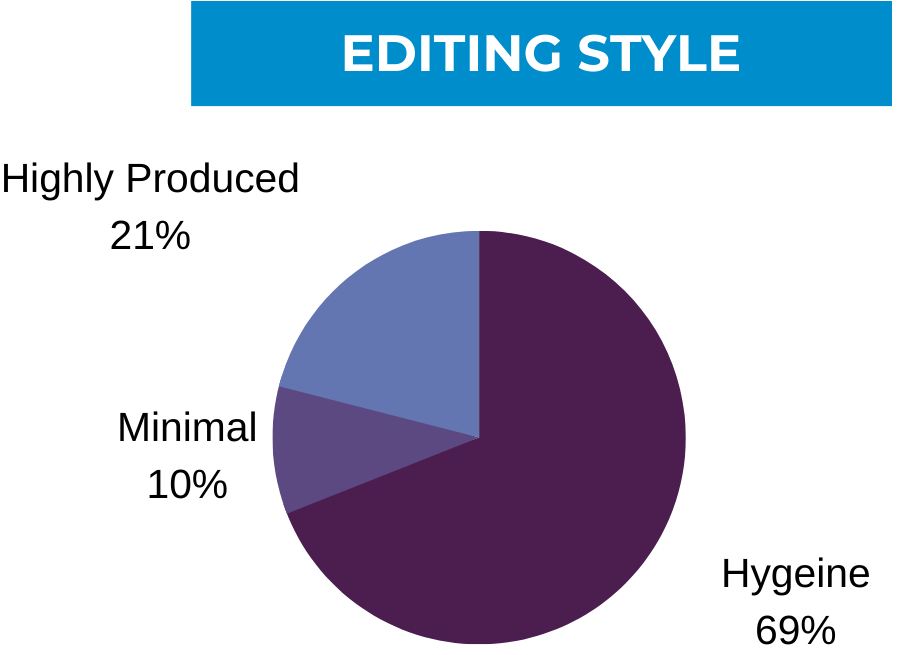
Let’s look at the editing style used by the top 100 podcasts.
Before we start talking about the numbers, I want to put forward that really good editors are going to make a highly produced show that took a huge amount of time and effort to create a sound like it was recorded off the cuff by brilliant people and ed directly into your feed.
We cannot know for sure what editing styles and strategies were used – we’re going by what it sounded like, and that is our interpretation.
This year it sounded like normal hygiene style editing was by far the most prevalent, with 69% of shows using it – this is slightly down from 73% last year.
This is a type of editing that takes a conversation and makes it sound like a particularly eloquent and smooth flowing chat by normal people. The effort that goes into creating that effect is, as mentioned above we have no way of knowing.
I was delighted to see that the shows that seem to put no thought whatsoever into editing are down from 21% to 10%. The listening world thanks these shows for not making us listen to unedited episodes.
I would like to, if any top 100 hosts are listening remind 4 of you who have otherwise great editing to buy a gosh darn pop filter, or back off your mic an inch or two.
The final group was highly produced shows (21% this year compared to 14% last year) – this is a narrative, musically enhanced, news or documentary style of editing.
This is out of the question for most company shows – the production costs are too high for the benefit the podcast brings, but when it is possible, it can be a lot of fun and allow everyone involved a lot of creativity while creating high value assets for a business.

This was an interesting part of the data this year. For the first time since we’ve started this report, the most popular intro type was not a standard produced intro with music and voice over, but what sounded like a live intro with a music bed underneath.
Strategically, I like this a lot, it gives the host time to really think about the content and make a good introduction of it to listeners – and it can be recorded alongside the rest of the music OR separately after the call or recording.
A handful of shows just… started – often these were video-first shows that were just dumped into a hosting company after being recorded, and there were also some that had just a piece of music or short tone/stinger then launched into the content of the episode.
I did not count what sounded like pre-roll ads in these numbers- more on sponsors later!
Similarly, more outros were live over music- it really is an elegant and efficient way to begin and end a show. 21% had produced outros and a significant percentage either just ended or had just music at the end – again, we’re looking at you video-first shows.
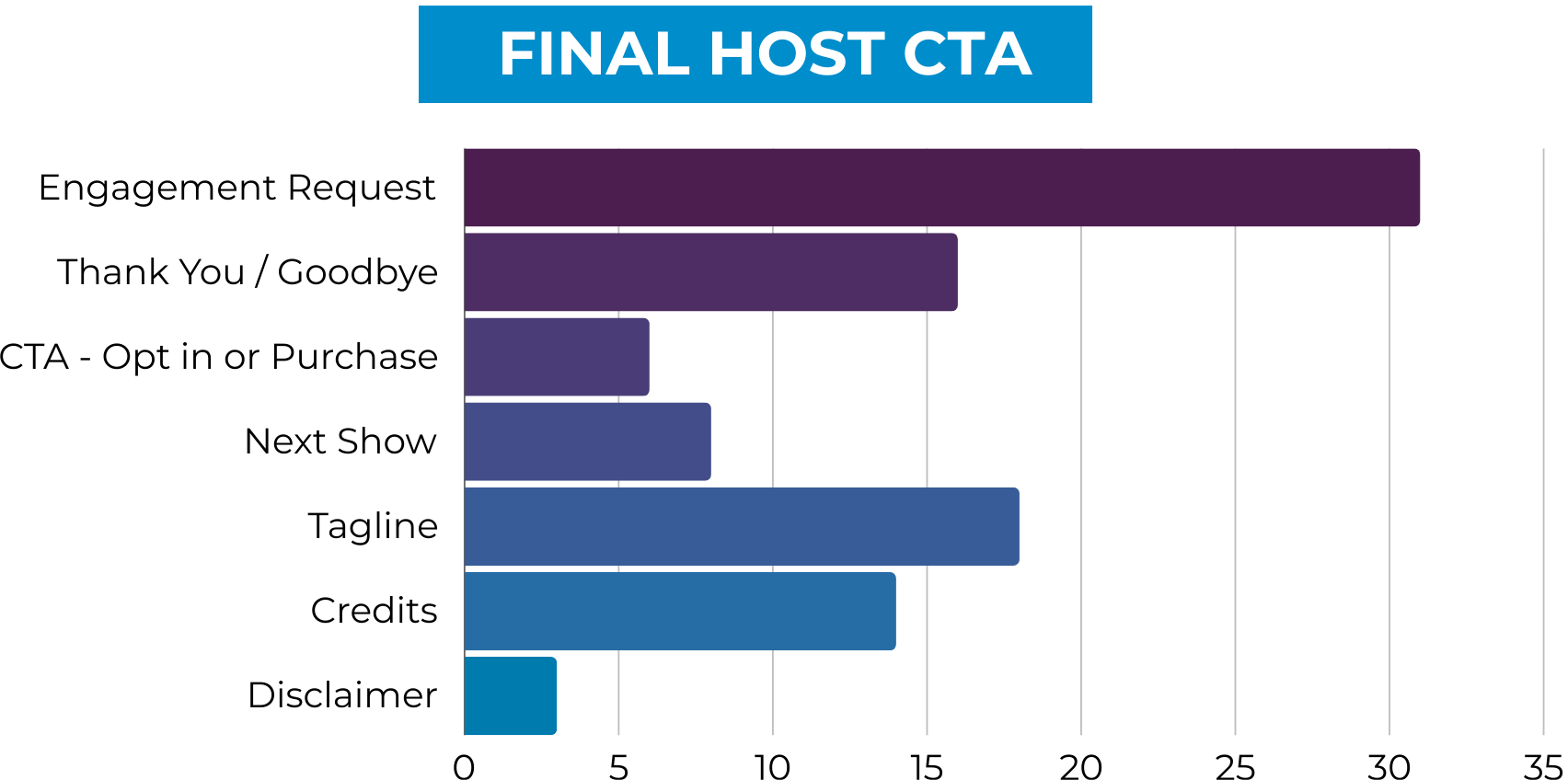
This is always a fun part of the research. This is the last thing a host at the end of the show. If there was a voice over, we considered that a produced outro.
An engagement request was the most popular final CTA. This would be something like: “comment, share, subscribe!” or my new absolutely least favorite podcast term of all time “pay the Fee!”
Thank you or goodbyes could refer to either the audience or the guest. CTA is for either an email opt in or something that can be purchased.
A preview of the next or another show is a wonderful way to end an episode and keep attention on the fact that MORE IS COMING.
Credits were up a little this year, thanking the network or creative team behind the podcast, disclaimers are important for many shows, especially around finance, law and health topics, and taglines are a set phrase that gets repeated every episode – they can be a lot of fun, and make people feel like insiders in your community.
Networks and Sponsors
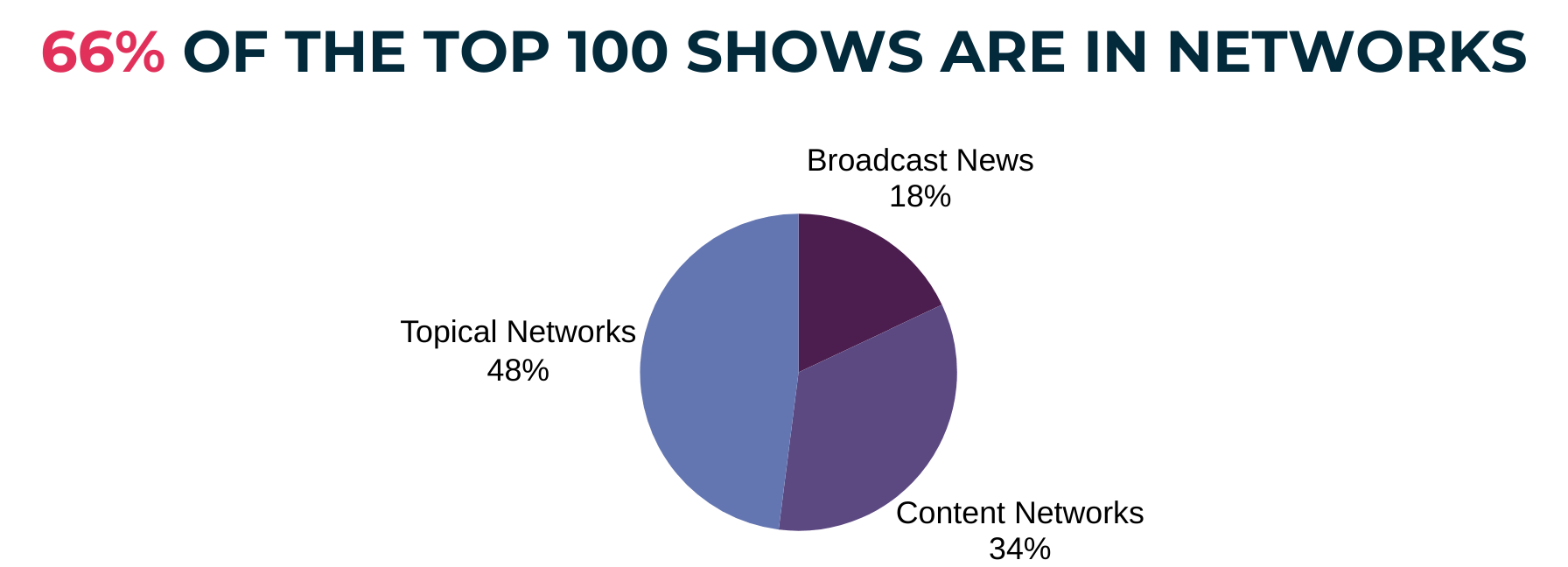
There was a large increase in the number of network shows this year, with 66% of the top 100 being a part of one (compared to 51% last year).
The network types we look at are Topical, Content and Broadcast.
Topical – 48% of network shows. Topical networks are collections of shows on a particular topic or theme. Creating those shows may or may not be the network owner’s only goal, and the shows can all be created by the network or be created independently and presented together. Think about the Compliance Podcast Network, or the Motley Fool.
Broadcast Networks – 18% of total shows. Broadcast networks are usually larger multi-media or broadcast or news organizations – think NPR, HBR and CNBC.
Content Networks – 34% of all shows. These are networks that design and produce their own original content as their main business activity – think Wondery Media or BFFs.
This network participation could be a function of the overall increase in competition for listeners. The support of a network both in launching a new show, and connecting a new show with an existing audience cannot be overstated. If you don’t want to go the network route, which can mean a loss of some decision making power, think about the benefits of networking, like shared audience, shared promotional budget, and cross-promotion – connect with other independent podcasters to try and replicate it with each other.

There were just a shade more Premium versions of podcasts available this year of them this year, but still a small overall percentage: 14% – this is probably because for the vast, vast majority of business podcasts, putting anything behind a paywall is a waste of your CTA, and the least effective way to monetize your show.
What you can get in terms of brand awareness, relationship building and promoting your own products and services is typically much more valuable than a small subscription payment to enjoy a show without ads.
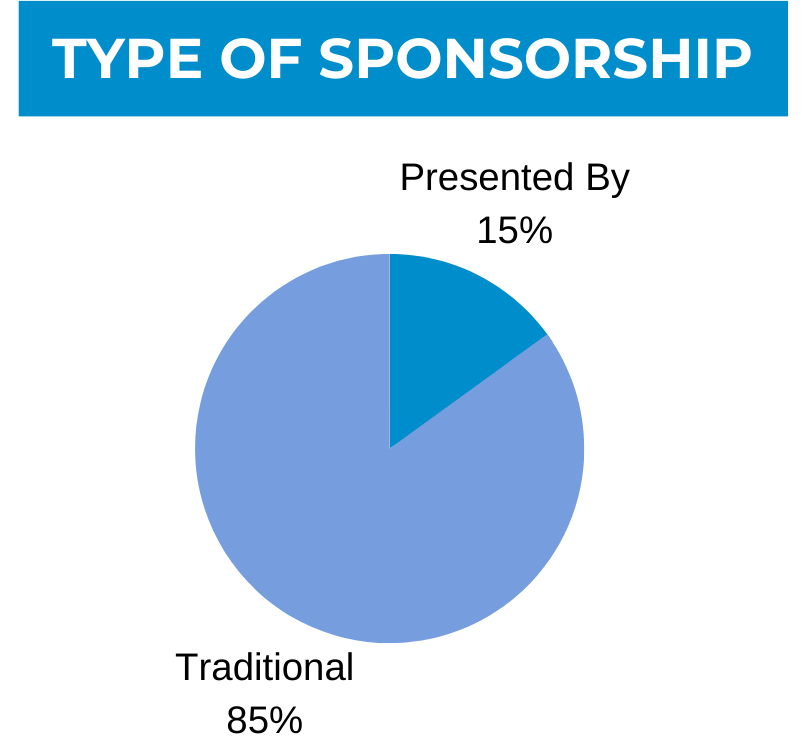
Now, let’s get into sponsors – there was a massive jump in sponsored podcasts in the top 100 this year with 15% of those being a whole-show or presented by a sponsor.
To briefly call back the Business Podcast Blueprints, usually we would see sponsor ship mostly in Audience Engagement and Content shows – with the major exception of “presented by” sponsors – a company sponsoring the entire production of a podcast is very much a thought leadership move.
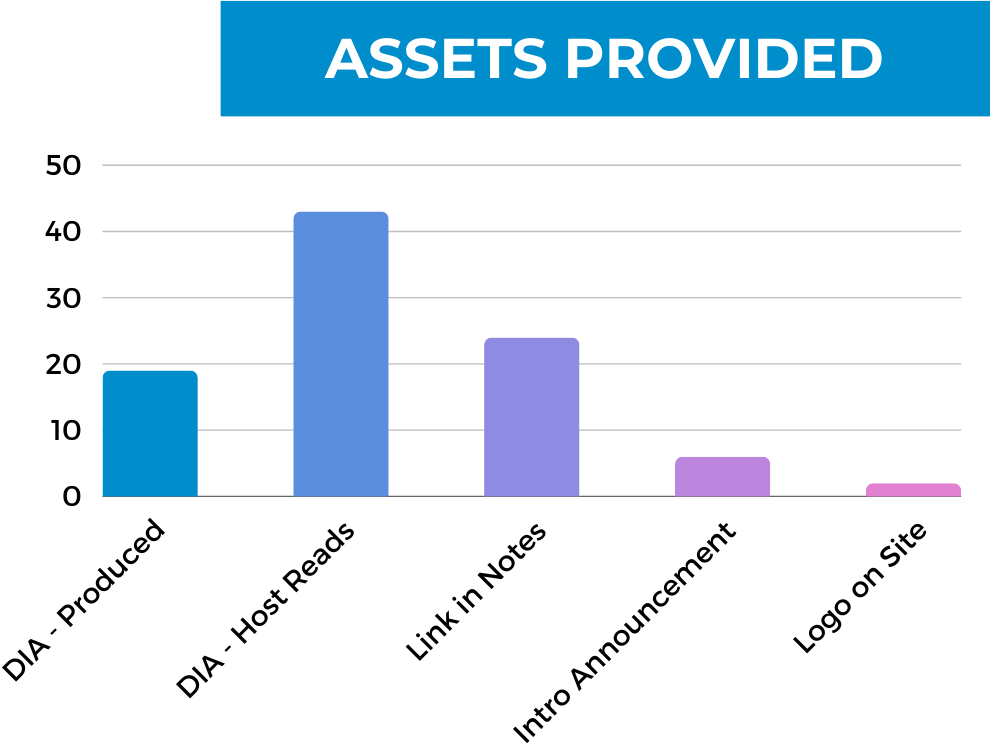
We looked more closely at the sponsor assets provided this year – last year I was surprised by what seemed like the paucity of assets given to sponsors, and this year was not very different.
Host reads are, of course, the most valuable type of sponsor assets, it’s the personal endorsement by a person known to an audience that fetches the highest price – and that kind of more personal sponsorship is also the most likely to include other assets like a link or logo on the website.
DIA or Digitally Inserted Ads from a marketplace were also pretty popular, and when they are used, the ad itself is typically the only thing the sponsor gets for their dollars.
If you are considering sponsorship for your show, I would strongly advise negotiating a deal that includes your host read ads, but also other elements like links in show notes and on websites, and maybe even on your social media platforms, in your newsletter and the other touchpoints you have with your audience.
The audio of your podcast is, as always, just the start of the reach that you actually have with your podcast.
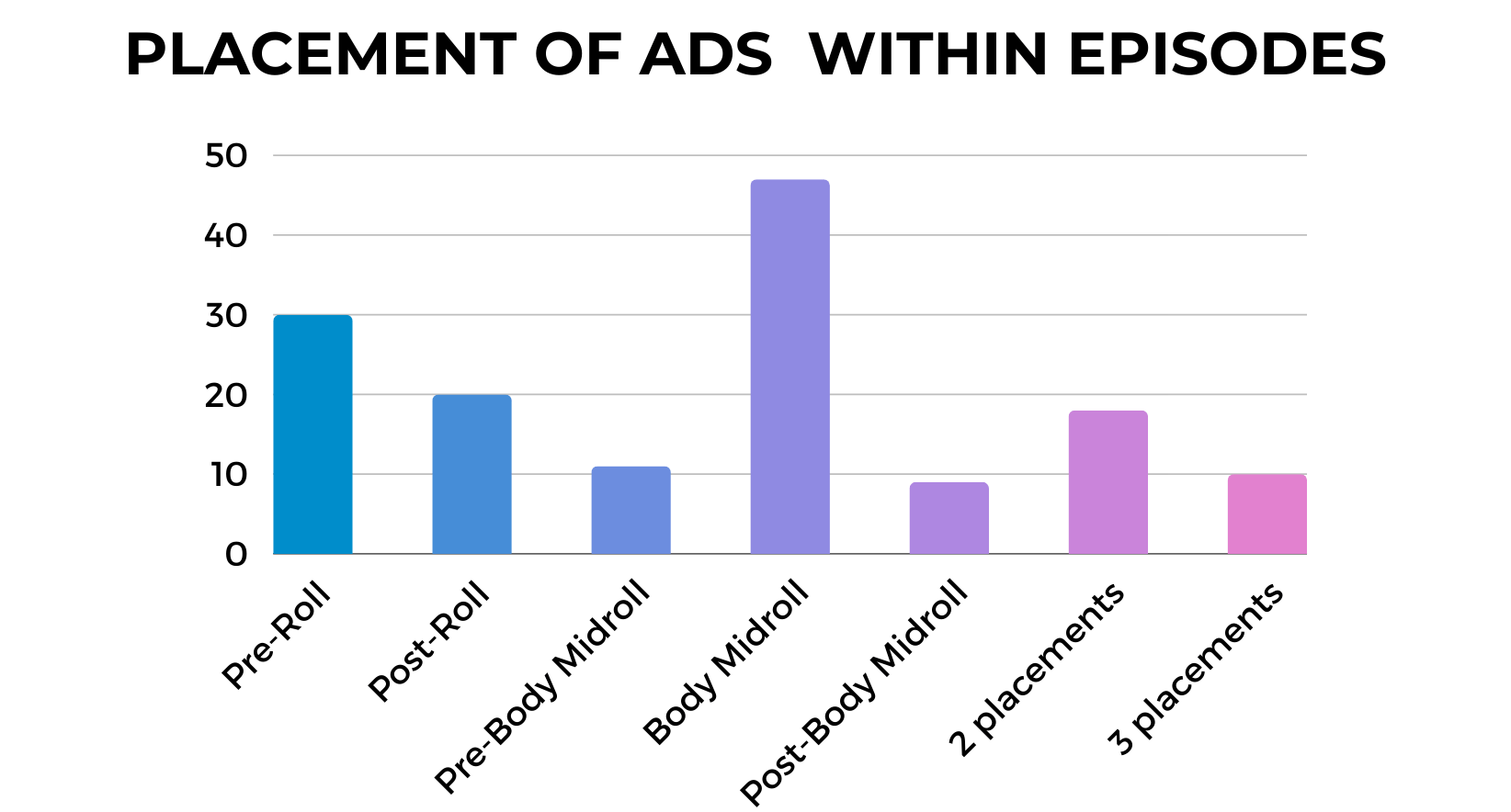
Now, for ad placement.
We’ve got your pre-rolls and your post rolls – content that runs before the show’s intro, or after its outro – these are typically the least valuable sponsor slots, and pre-rolls are often better used talking about special, limited time things going on at your business.
Midrolls are far and away the most popular placement, and we divided these into different categories: pre-body midrolls which are after the intro matter, but before the main meat, body midrolls which happen in the middle of episodes and post-body midrolls which are before the closing materials on a show.
Pre-body and body midrolls are solid sponsorship slots, but you have to be careful with post-body midrolls – it’s easy for someone to stop listening when they hear an ad start close to the end – and that could mean a listener misses your call to action, which could be much more valuable to you than a sponsor payment.
About 28 of the shows with sponsors that we evaluated had multiple ad spots in the podcast – the others restricted themselves to one – although that one can contain multiple sponsors!
Be mindful of how many ads you are making your audience listen to – they’re here for you, not the sponsor.
Notes and Websites
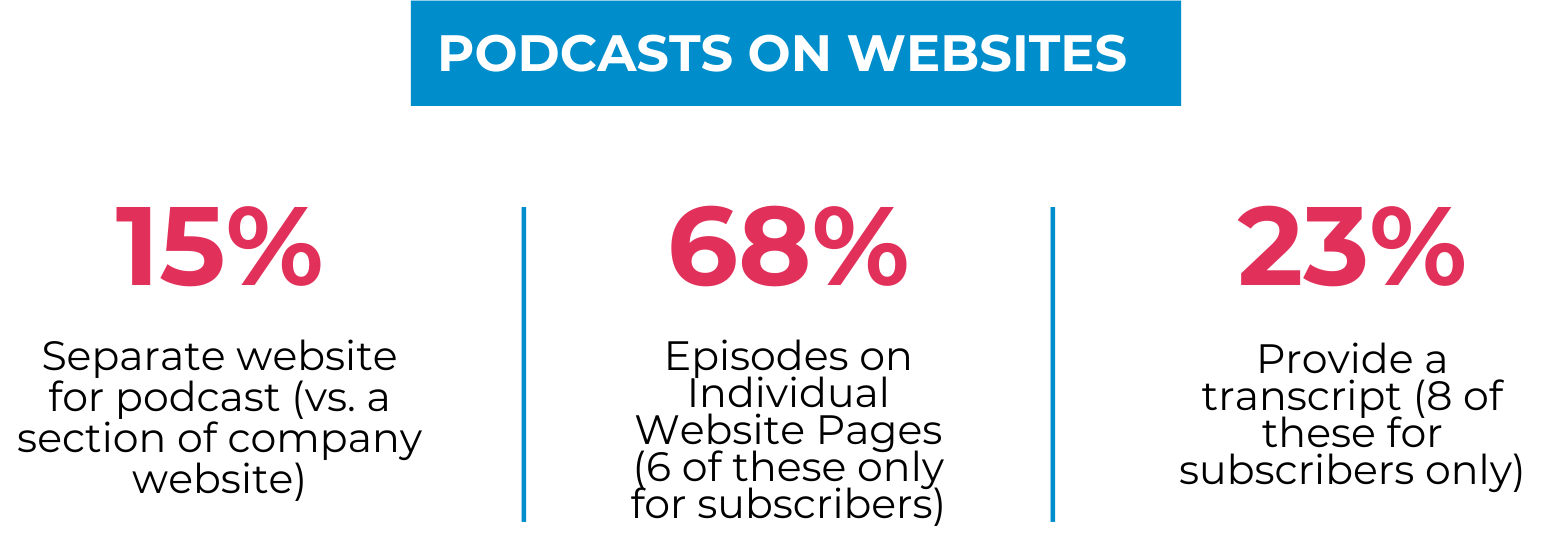
A question that I get a lot as a producer of podcasts is: should it get its own website? In fact, this was one of the questions that inspired this entire report back in 2020 when we published the first one.
With 85% of the top 100 including their podcast on their main business website and 68% of podcasts creating unique pages for each episode – that is pretty much what you should be doing.
Something I found surprising was a major drop in the availability of episode transcripts this year – we found 23 instances of transcripts with each episode, which is down from last year’s 41% and 2021’s nearly half. and 8 of those were restricted to subscribers of some kind.
This is not a great sign for accessibility, and I am curious as to why it seems to have been de-prioritized this year.
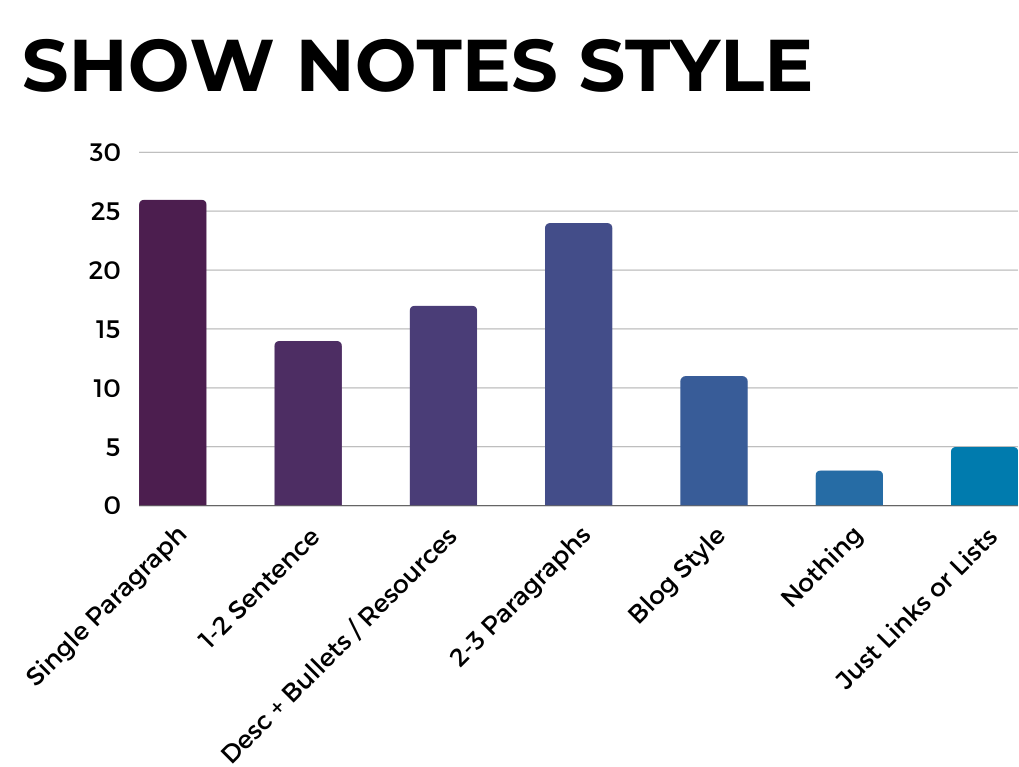
Overall, the paragraph style part of show notes was longer, and fewer shows provided bullets of highlights, questions or key points.
The number of hyper-short, single sentence or link only notes was also way down, and I think what we’re seeing here is more aggressive AI use in show notes production.
It’s easier to get a couple of paragraphs of content out of a whole episode now – and that takes a heck of a lot less time to edit for accuracy and quality than a whole transcript a long list of bullets, or a blog-style post. – as the sophistication of this technology increases, who knows what we’ll see. I do laud the top 100 shows for electing shorter notes that are well edited than a big old pile of under-unfriendly lists.
I’d like to see more transcripts, though.
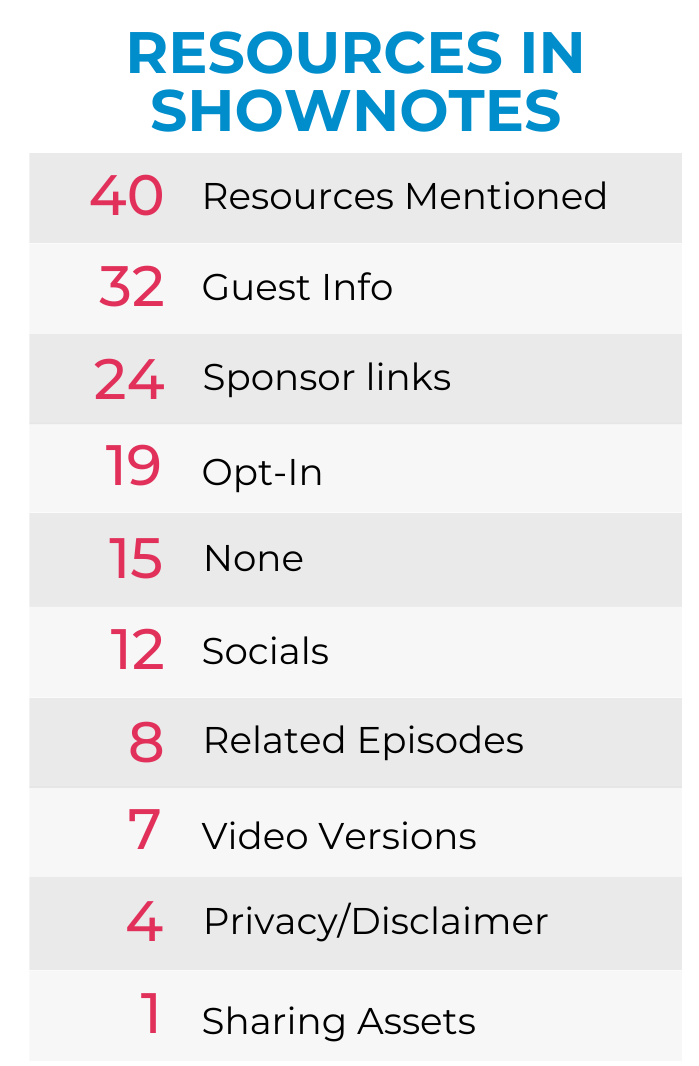
Now – onto resources.
The different kinds of assets included in notes were fairly consistent this year compared to last with links to resources being pretty high ranking.
Guest information and links were slightly down – perhaps the hosts find that the airtime is more valuable for talking about the guest, but I have found in production that airtime is best left for actual conversation and information.
Guest bios are useful in terms of demonstrating someone’s ability to provide information, and of course, links are just a common courtesy for someone who is giving you free content.
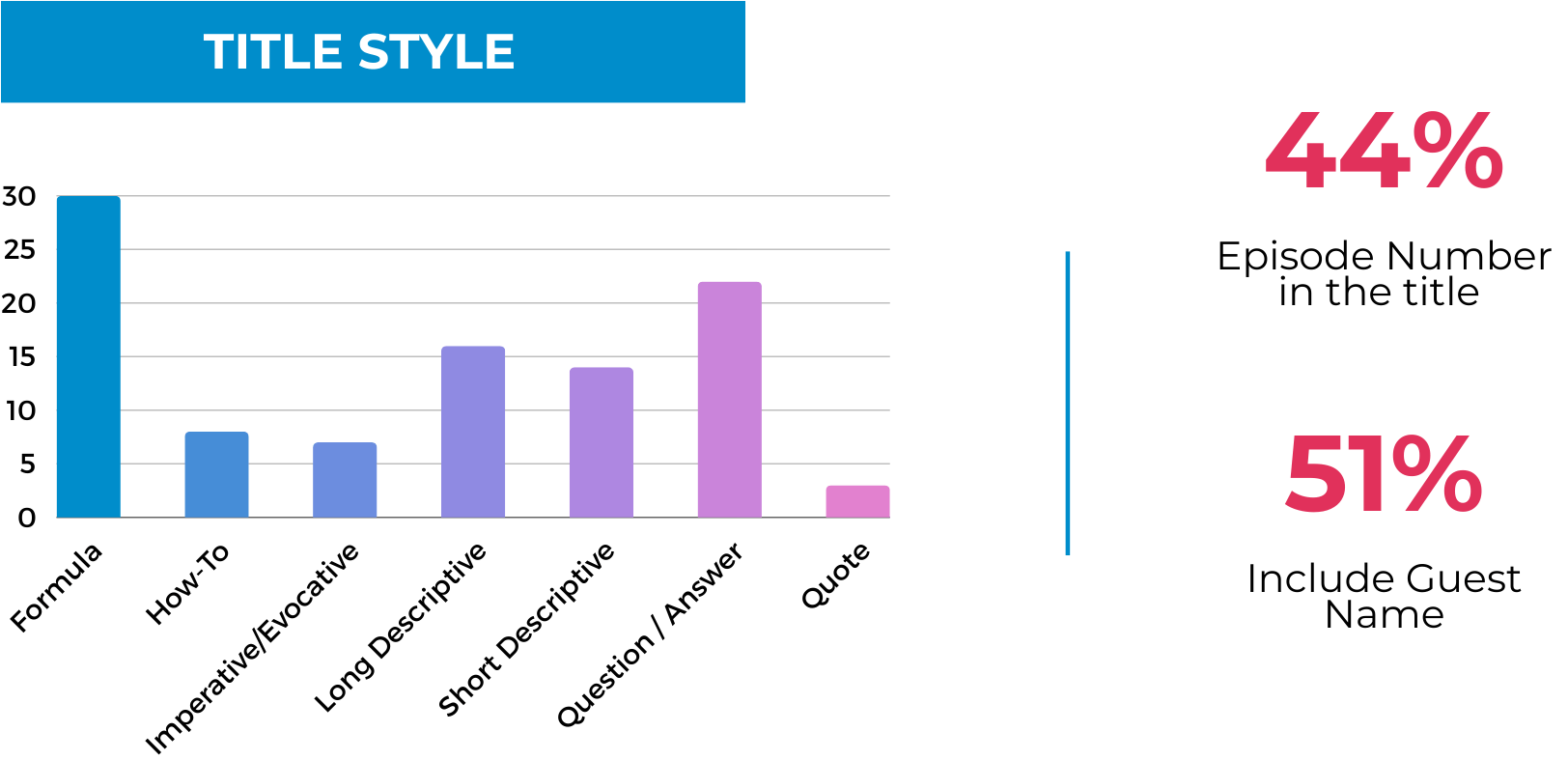
There were some slight increases in the use of guest names and episode numbers this year.
Names of guests increased from 40 to 50% and Number of the episode increased from 37 to 44 – it seems to be trending in the direction of including them. Do remember that a lot of these shows have a LOT of episodes, and 241 sounds a lot more impressive than 12.
Title style was something new we looked at this year, and formulas were big! A title formula is a particular order of parts that are reused for all or most episodes.
Some of the examples we say were:
- Declarative Statement – Topic with Guest Name
- “Guest Quotation” – Guest from Business Name
- How-To – Explanatory Statement
When you look at your most poular episodes, take a look at the title formats those episodes used – there might be a specific formula, or set of formulas that make the best impression on your listeners.
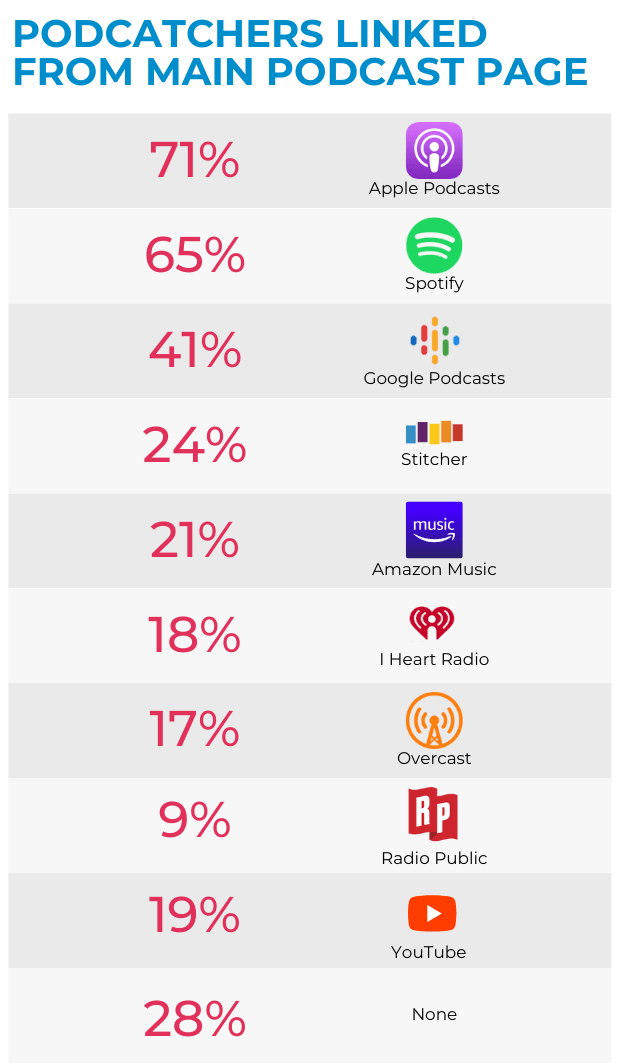
We look at the podcatchers listed on each website to help determine how the top 100 podcasts are thinking about the different platforms their users might be listening on.
Overall there is a real decrease in the podcasters listed from main podcast pages – Apple went from 89% to 71, Spotify from 72% to 65%, and that trend continued all the way down the list until you get to None, which more than doubled.
Now, this could be attributed to an increase in YouTube focused shows, which we’ll be talking about soon.
I think it can also indicate that more companies are finding it less useful to direct traffic away from their own websites to a podcast player, and that more of their time spent directing people FROM players and social media to their websites.
Social Media

Okay, let’s talk about YouTube.
So, all of the data recently has been about how YouTube is the biggest distribution platform and everyone needs to be doing live action video shows. There is even some compelling data to support it. But when I, and many other people I know have looked at that data – it was not reflected in our own experience in terms of downloads.
So when we were doing this year’s report we looked at if the top 100 podcasts were designed first for YouTube or for audio, and 43% of them were – these are huge shows that get massive numbers and friends, they’re skewing the YouTube results.
This isn’t to say video shouldn’t be a part of your strategy – as Tom Fox pointed out in the Conversation on Podcast reach at the Podcasting for Business Conference – adding shorts on YouTube can dramatically increase the views you get there – but it is shows designed first and foremost for video that are making it seem like everybody is and needs to be there all the time – that’s just not the reality.
We judged a show ‘video-first’ based on production quality, views, engagement and other assets created. Basically asking: was this designed to be seen as much or more than heard? If the answer was yes, we called it video-first.
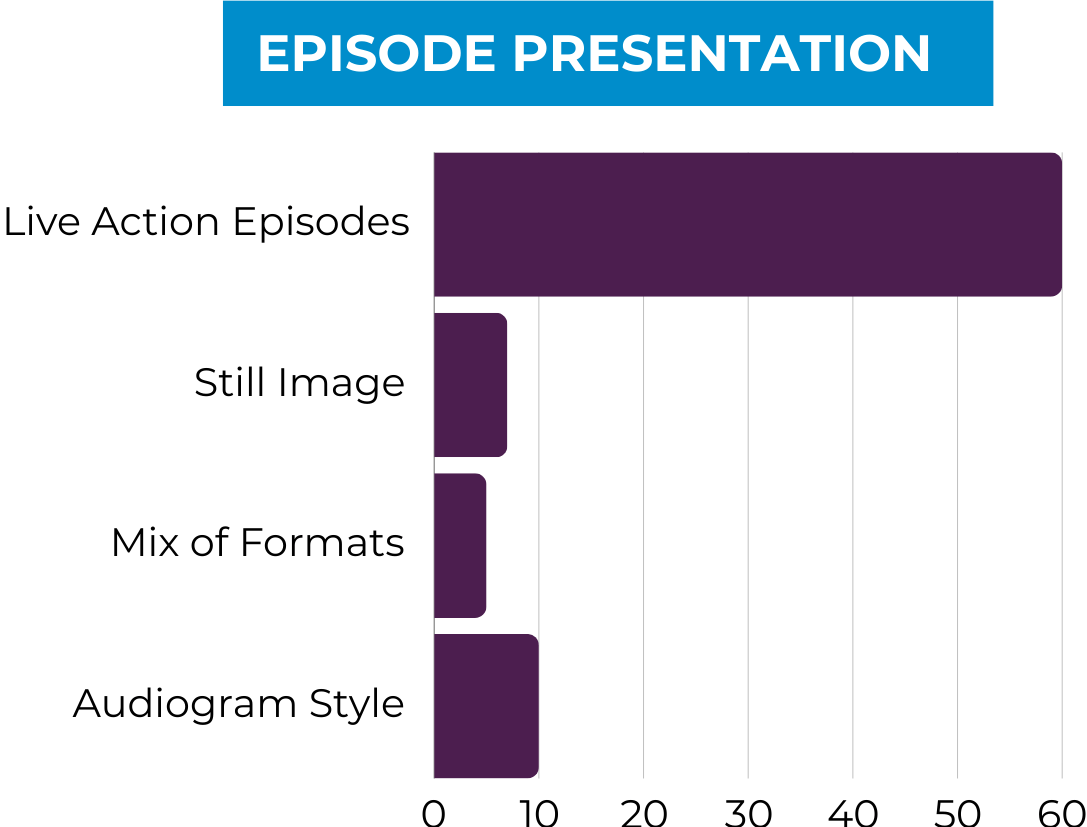
So, including the 43 video-first shows, 83 percent of the top 100 had YouTube channels, and 94 percent of those put their podcast episodes on YouTube, mostly in live action format, although there was also some still image which is a simple a graphic with audio overlay – this can be done automatically from many hosts! or audiogram style with an animated wave sign, which can be done automatically, or with a little massaging through a service like Headliner.
Interestingly – this is a dip from last year – 96 to 83 percent have YouTube channels.

Looking a little closer at some of the YouTube data, we’ve got the average channel size information here, and these numbers are actually a little smaller than last year for the most part, when the average number of subscribers was over 700,000 and this year we’re down to a more modest half a million.
But many, many shows were smaller, and when you look at how they’re using the platform – organizing the content into playlists, making YouTube and their visitors aware they have a podcast, and using podcast videograms and clips as shorts, there is tremendous potential for your own show.
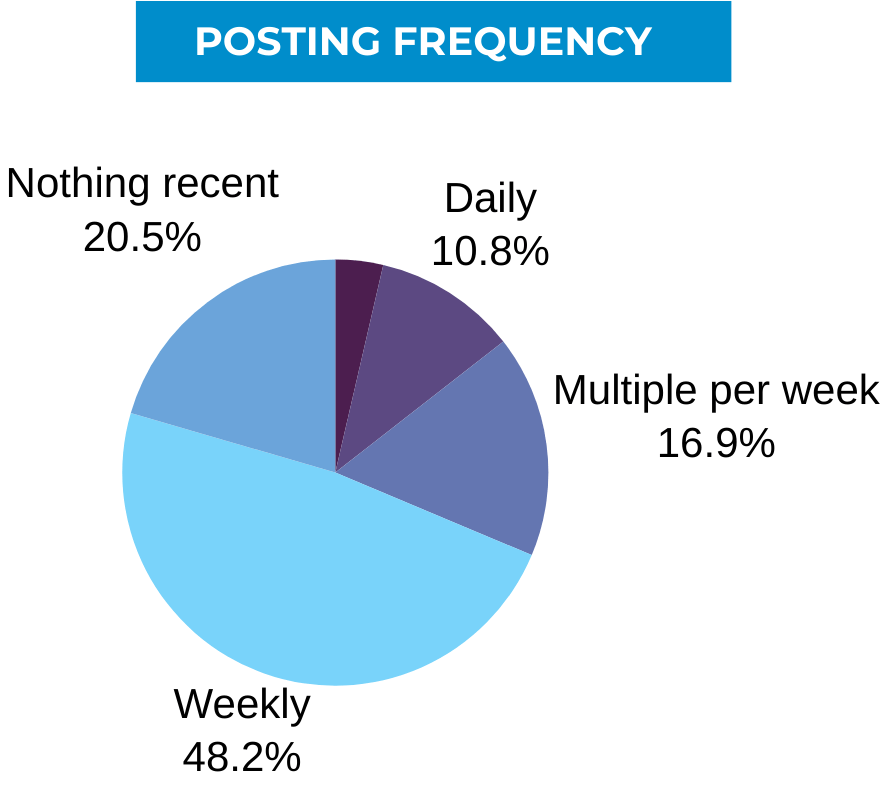
Release frequency on YouTube tends to reflect the podcast release cadence, for a lot of shows – although many YouTube channels have content other than their podcast there, and you can see weekly is by far the most popular release schedule for YouTube – although there were often more frequent shorts!

For reasons I am sure no one could possibly speculate upon, there were some big changes on Twitter/X.
The number of podcasts with show or host Twitter accounts dropped from 99% to 87% and of that 87% 31% had accounts that seemed to be abandoned over the last year. Last year only 12% of the top 100 Twitter/X Account had been abandoned.
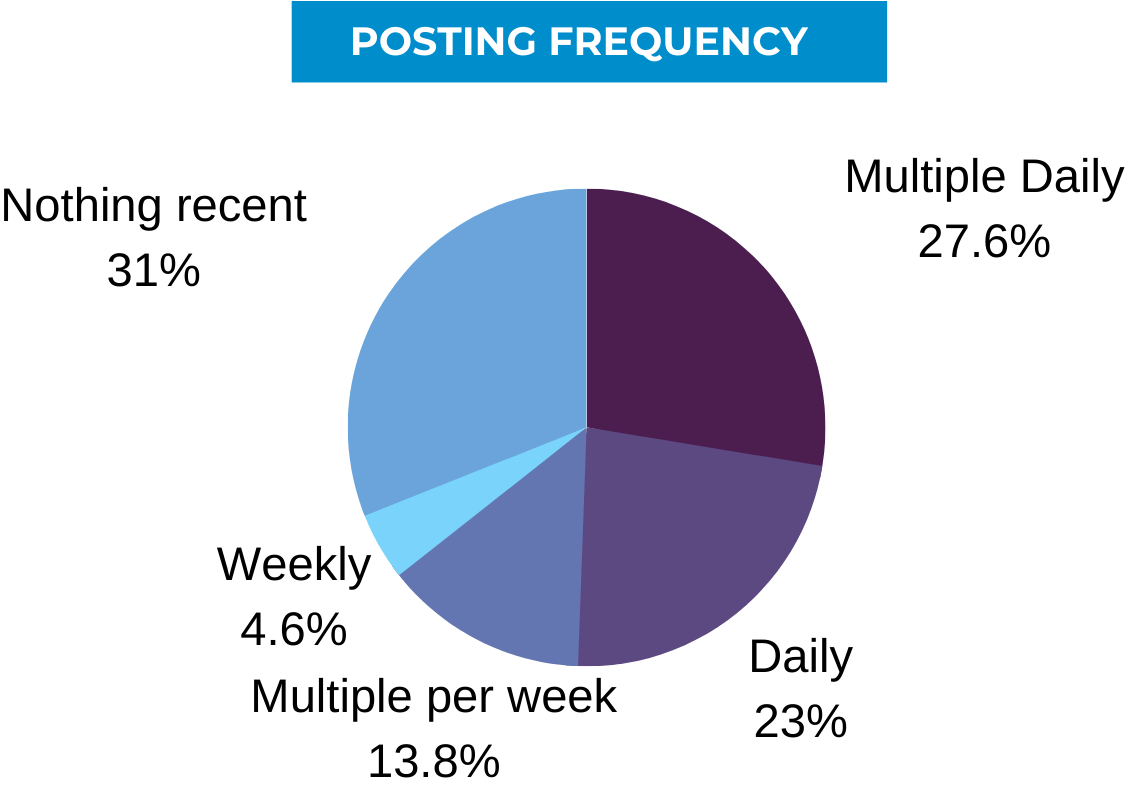
Of those still posting, they are posting a lot – daily or multiple daily make up the biggest percentage. That is also a lower result than last year when 67% of the shows were posting daily or more.

Instagram is another platform that has taken a dip – not as noticeable as Twitter’s – but the number of the top 100 shows on Instagram has fallen from 94% to 78%, with a little over a third posting daily.
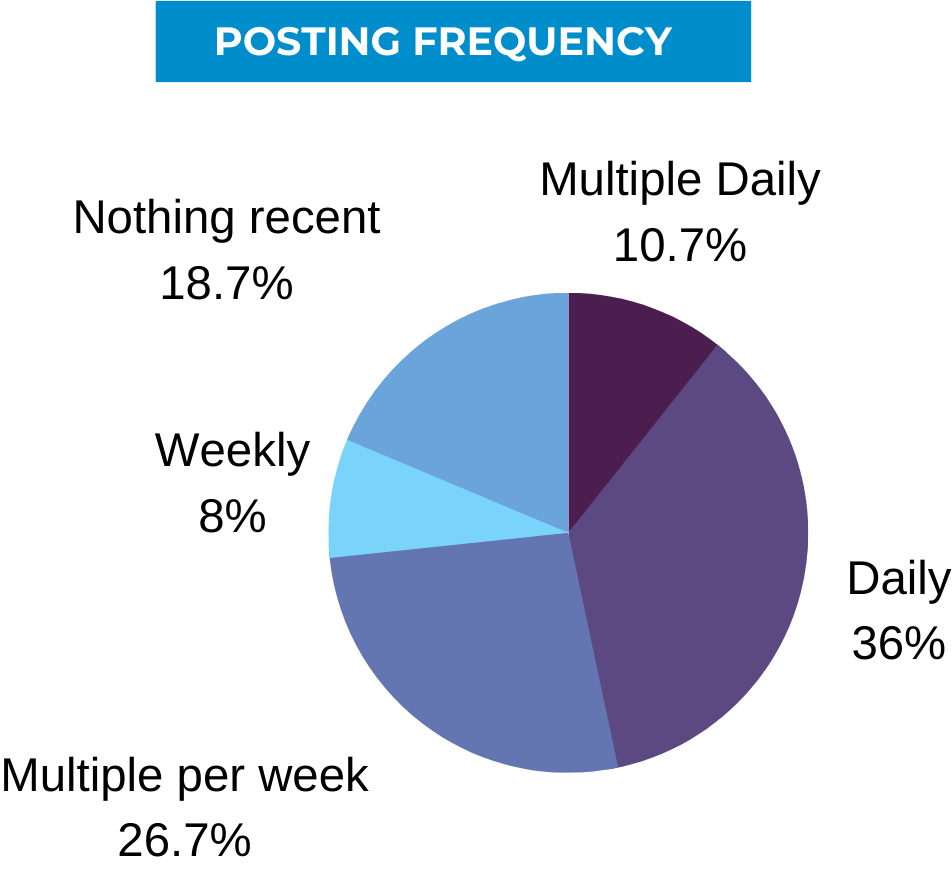
A few posts a week and multiple daily posts have basically changed places since last year, however, possibly indicating a focus on less, higher quality content.
Reels are still very popular with the shows using Instagram, and podcast content is present on most of them.
We’re really seeing a lot of podcast content repurposing across the board.

Moving on to Facebook, which is of course, part of Meta just like Instagram – small dip in Facebook usage compared to last year, from 89% to 80 having a Facebook page, although 25% of them have no recent content.
A significant number seem to exclusively auto-post from Instagram, and if Facebook isn’t a place where your audience spends time, it can be a good way to make sure there is fresh content for people who spend a lot of time there and might be interested in what you’re doing!
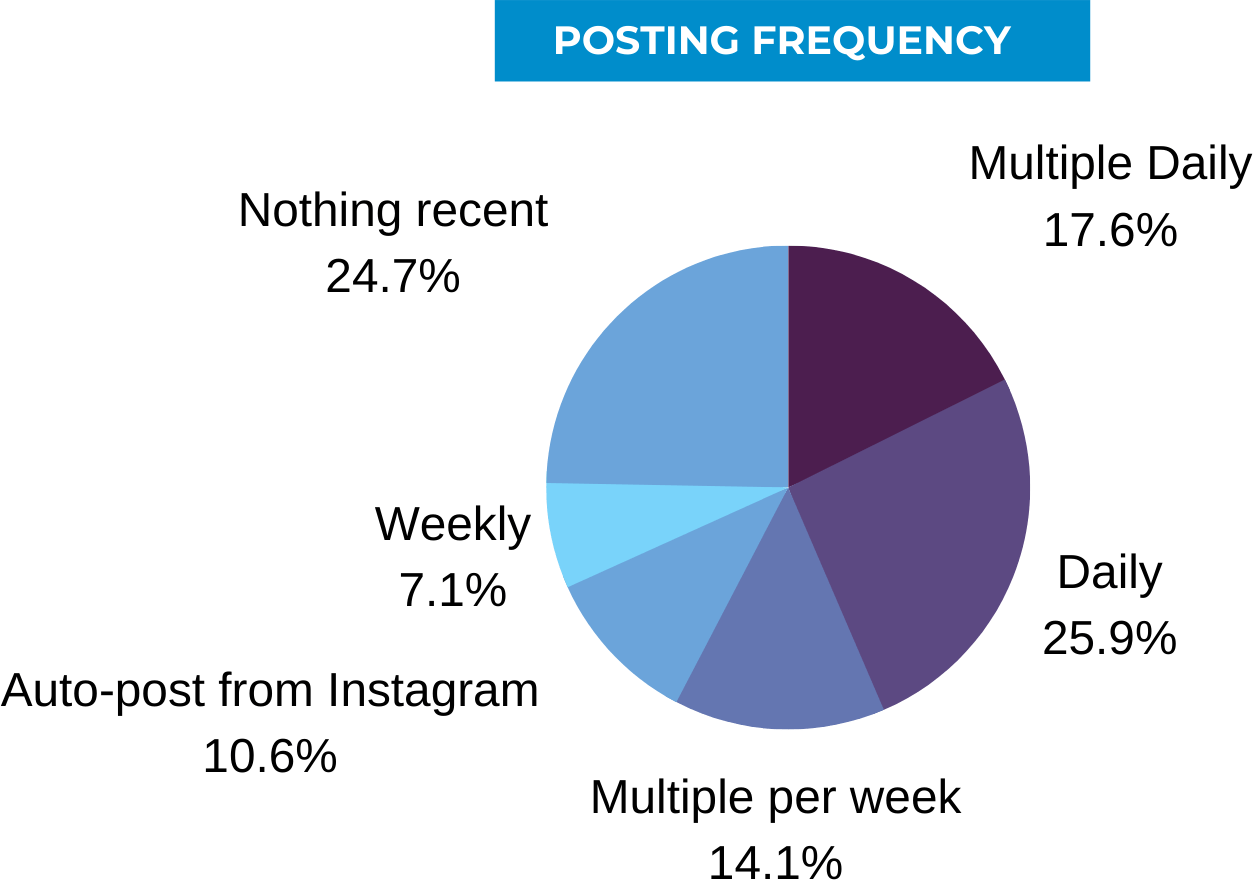

TikTok was fairly consistent in the number of shows that have accounts, a small dip from 61% to 56% – and looking at the median number of followers on these accounts there was a massive jump from about 7000 to over 200,00
80% of TikTok accounts use podcast content on their feeds, and again – those who post, post more. Daily uploads saw a major increase, from 12 to 31% for daily, there were some increases in other frequencies, but the daily change was the biggest.
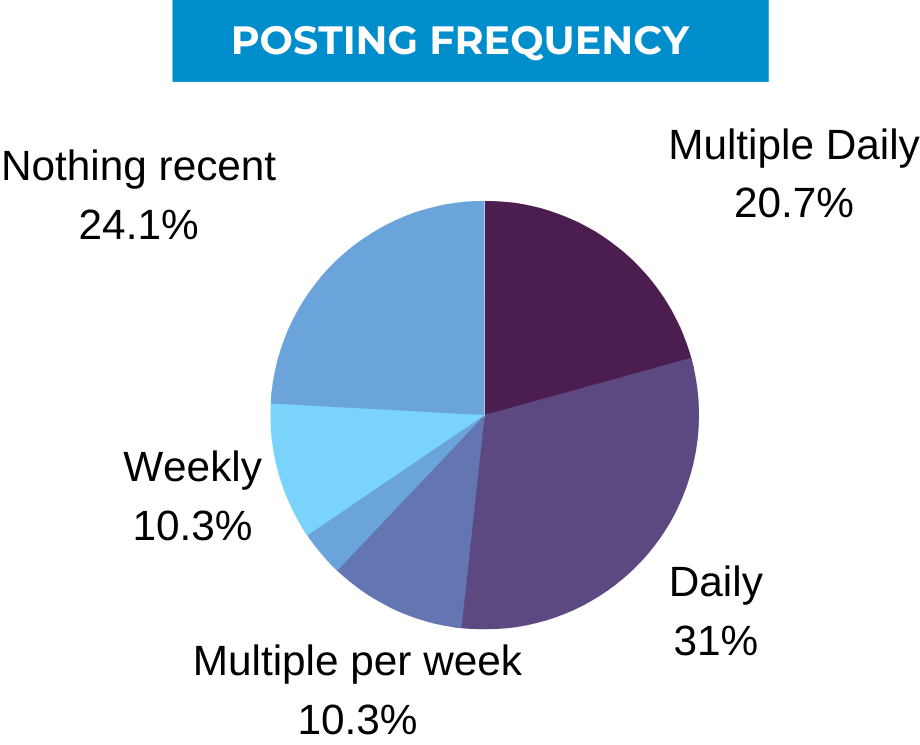
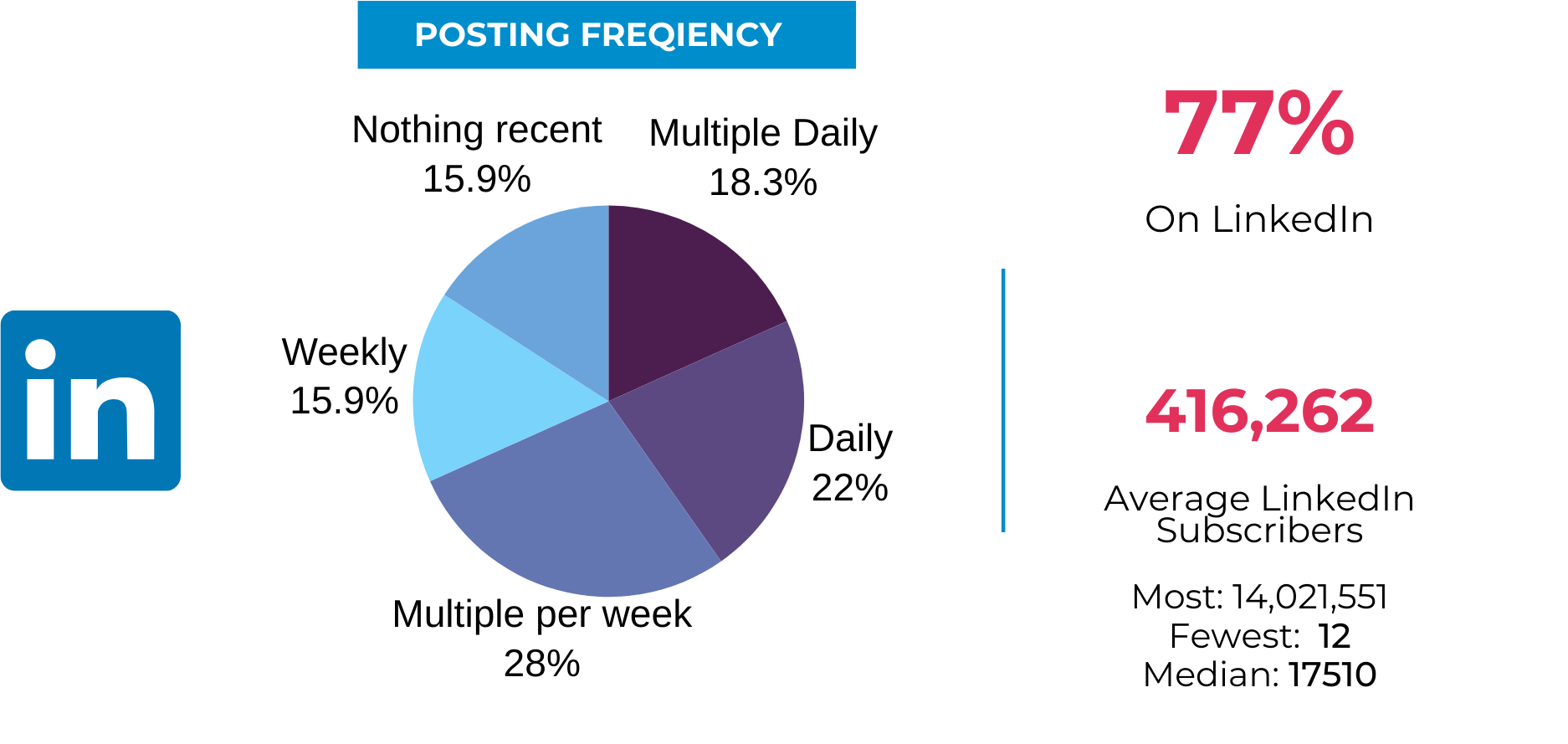
LinkedIn alone of the social media platforms we looked at, Increased in usage! It was modest, from 74% to 77%, but the posting frequency is way, way up.
Daily posts have increased from 10% to 22% of the shows using the platform, and multiple posts per week have increased from 11% to 28%. Multiple daily is about the same – those who post a lot, post a lot.
Final Notes
Social Media Strategy According to the Data
- Create a YouTube Channel and put full episodes on it – in live or audiogram format.
- Use playlists and the podcast feature, and use podcast clips in your shorts.
- Utilize Instagram/Facebook, and LinkedIn to promote your episodes.
Posting Frequency
- Instagram: Daily
- Facebook: Daily (Duplicate from Insta!)
- LinkedIn: 2-3 Times per week
(If you’re creating videograms anyway, might as well pop them on TikTok…)
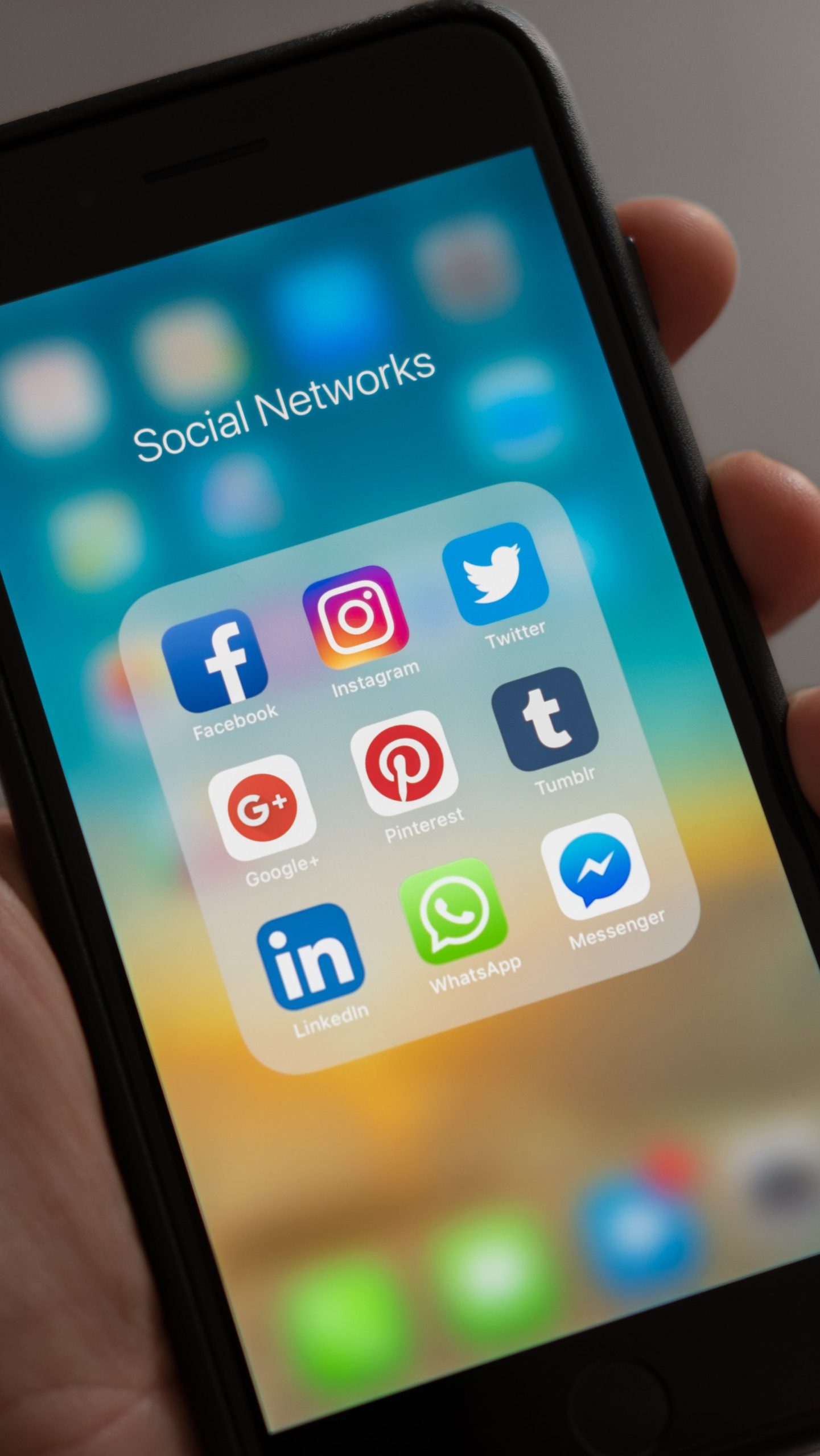
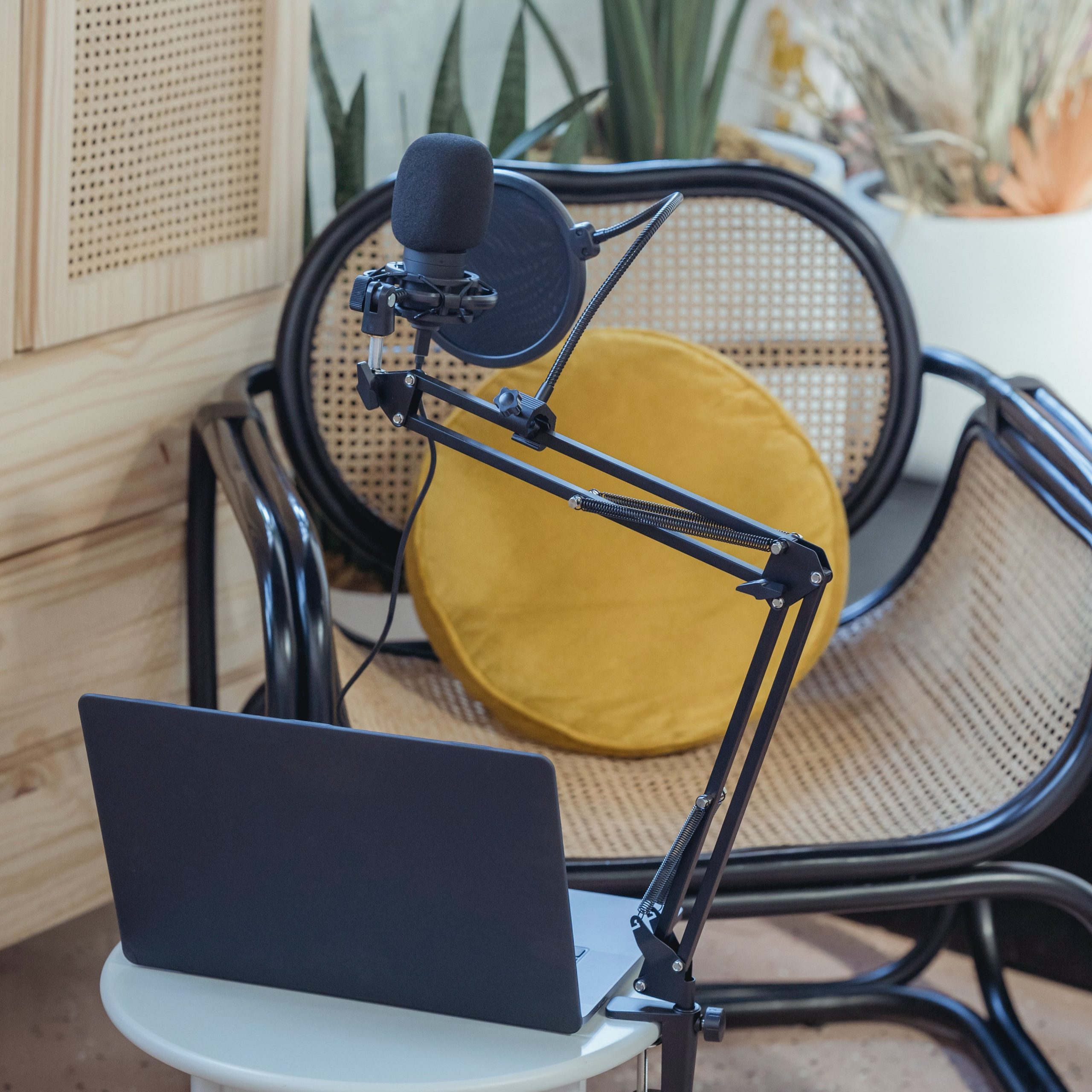
Key Takeaways
Your strategy should be based on your business goals, but all things being equal:
- Release weekly.
- Record the video of episodes for promotional purposes.
- Consistently engage on social media
- Use a headshot in your cover art.
- Have guests at least sometimes.
- Do a live intro and outro with music bed.
- Make notes at least 1-3 paragraphs.
- Include guests’ names in titles, and consider a formula.
- Ask listeners directly for the engagement you want.
Podcast Production Agency
Podcasting For Business Conference
Original Research
Connect on Social
LinkedIn / Instagram
